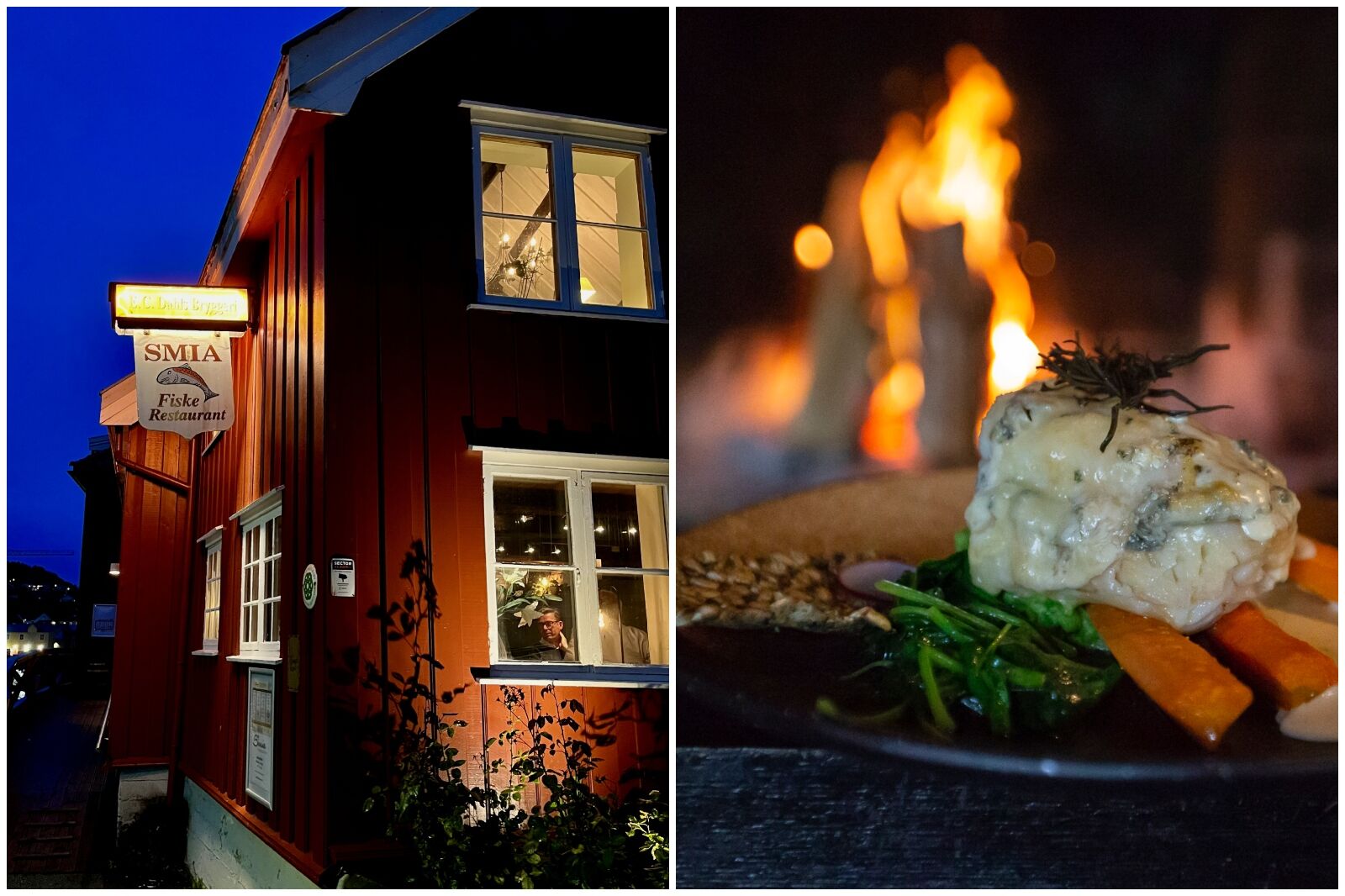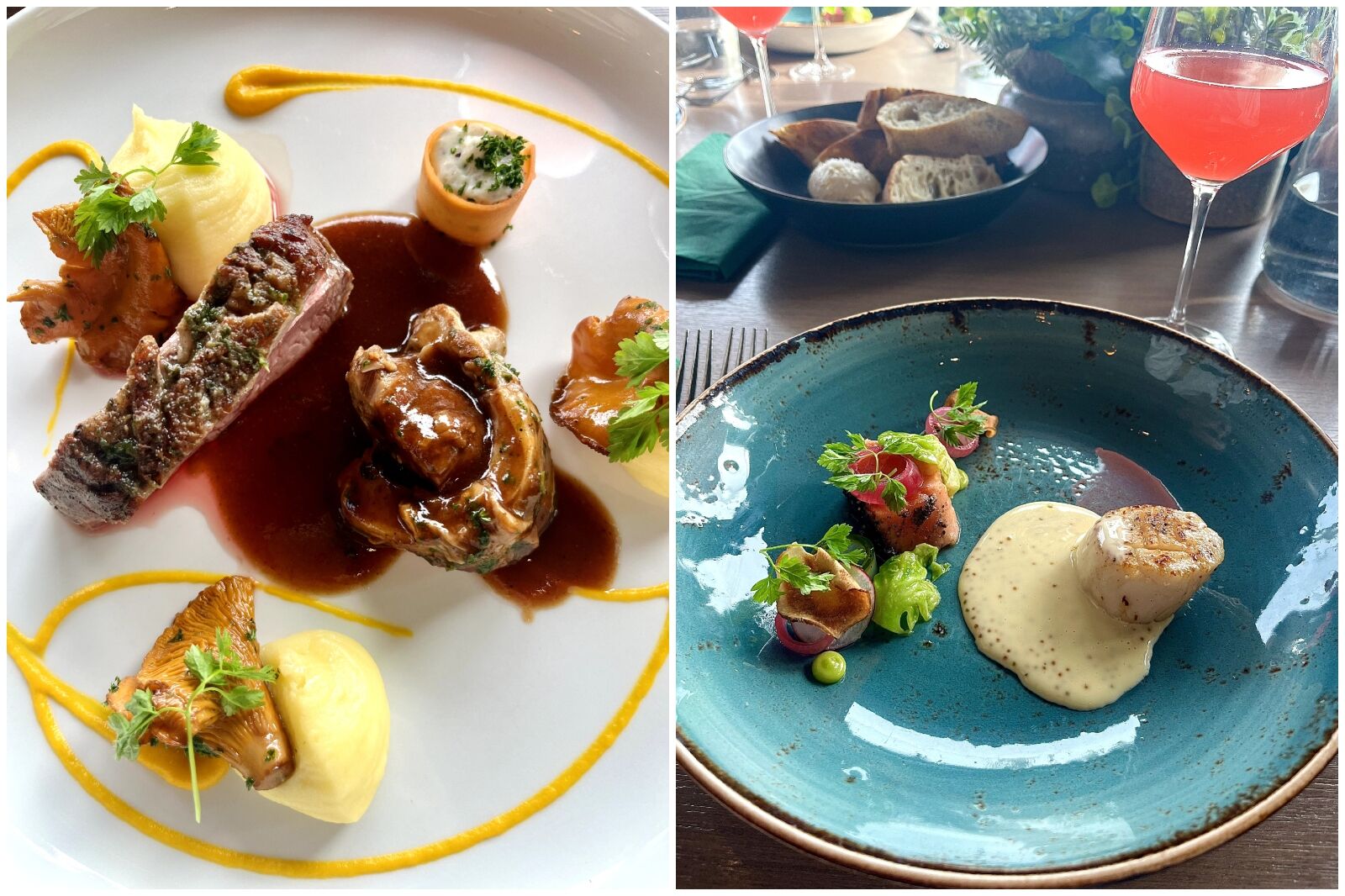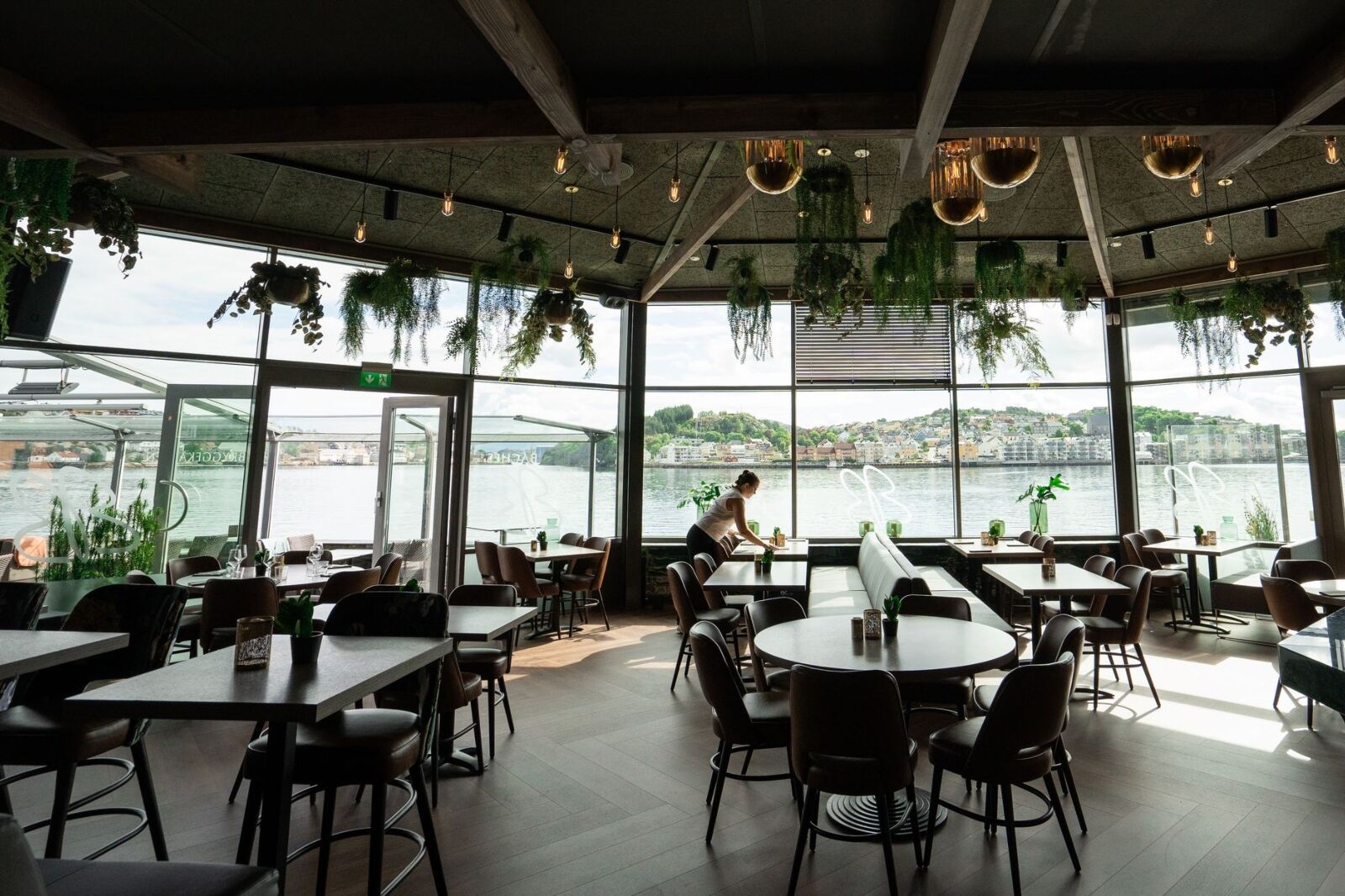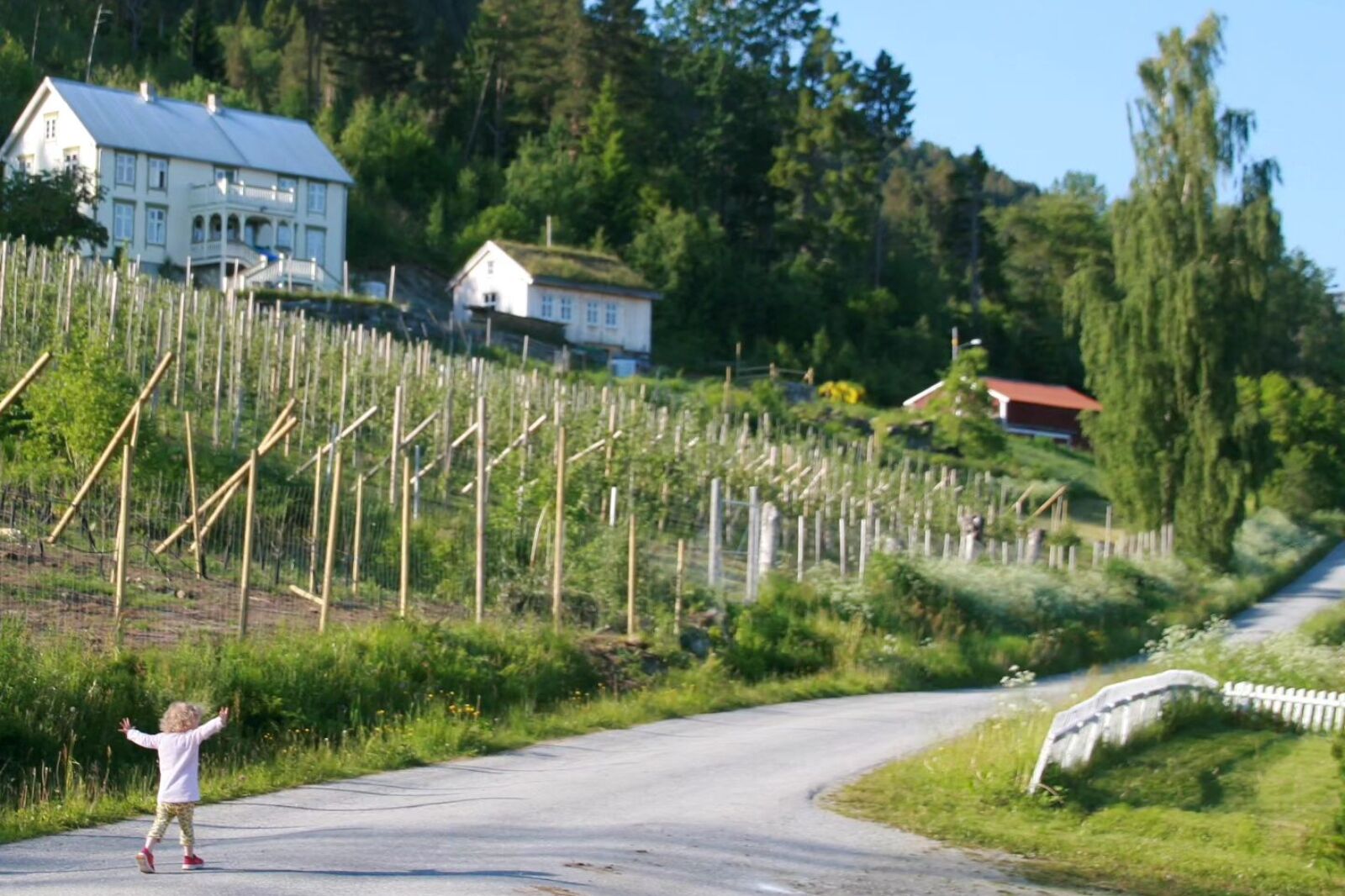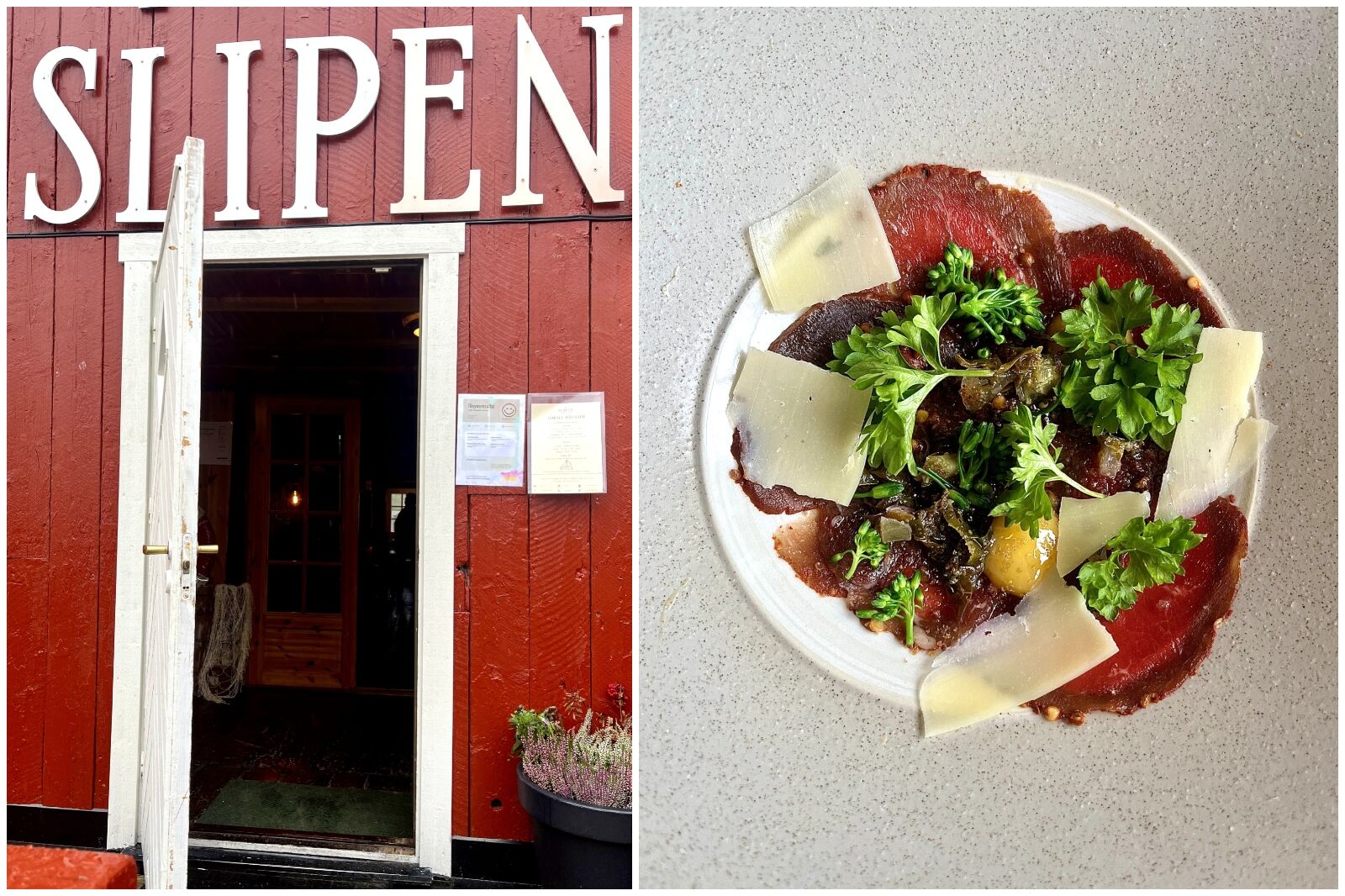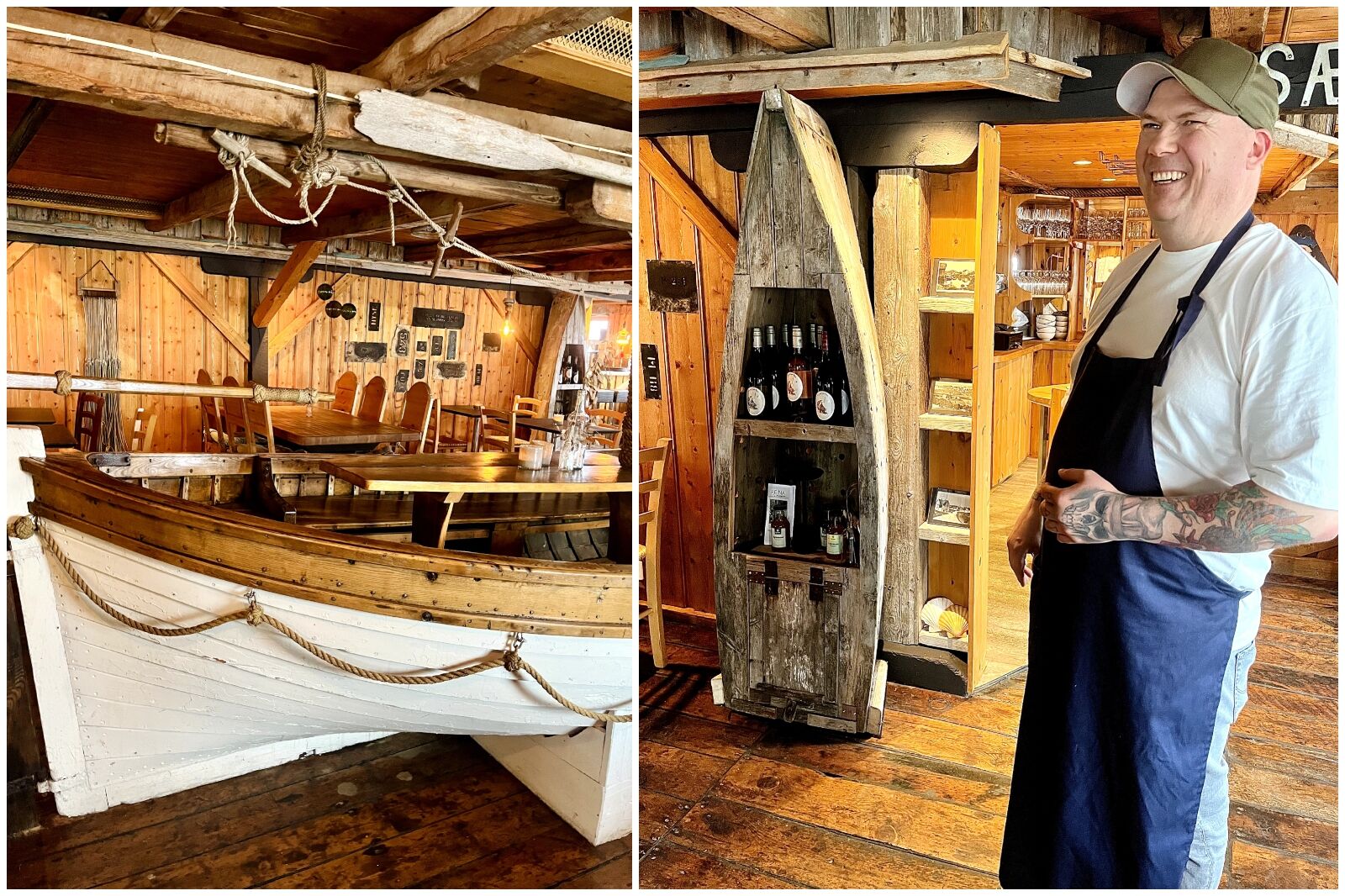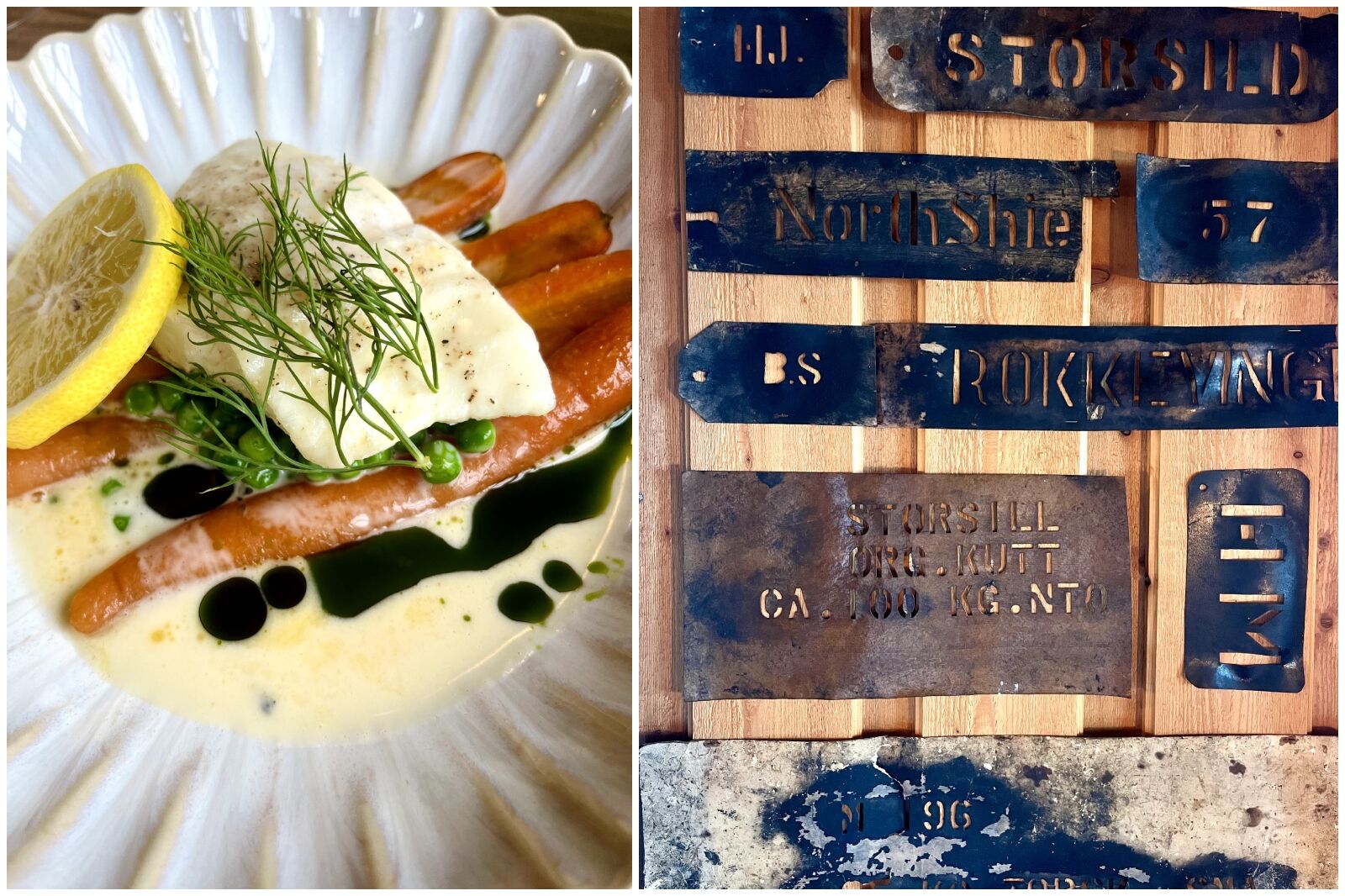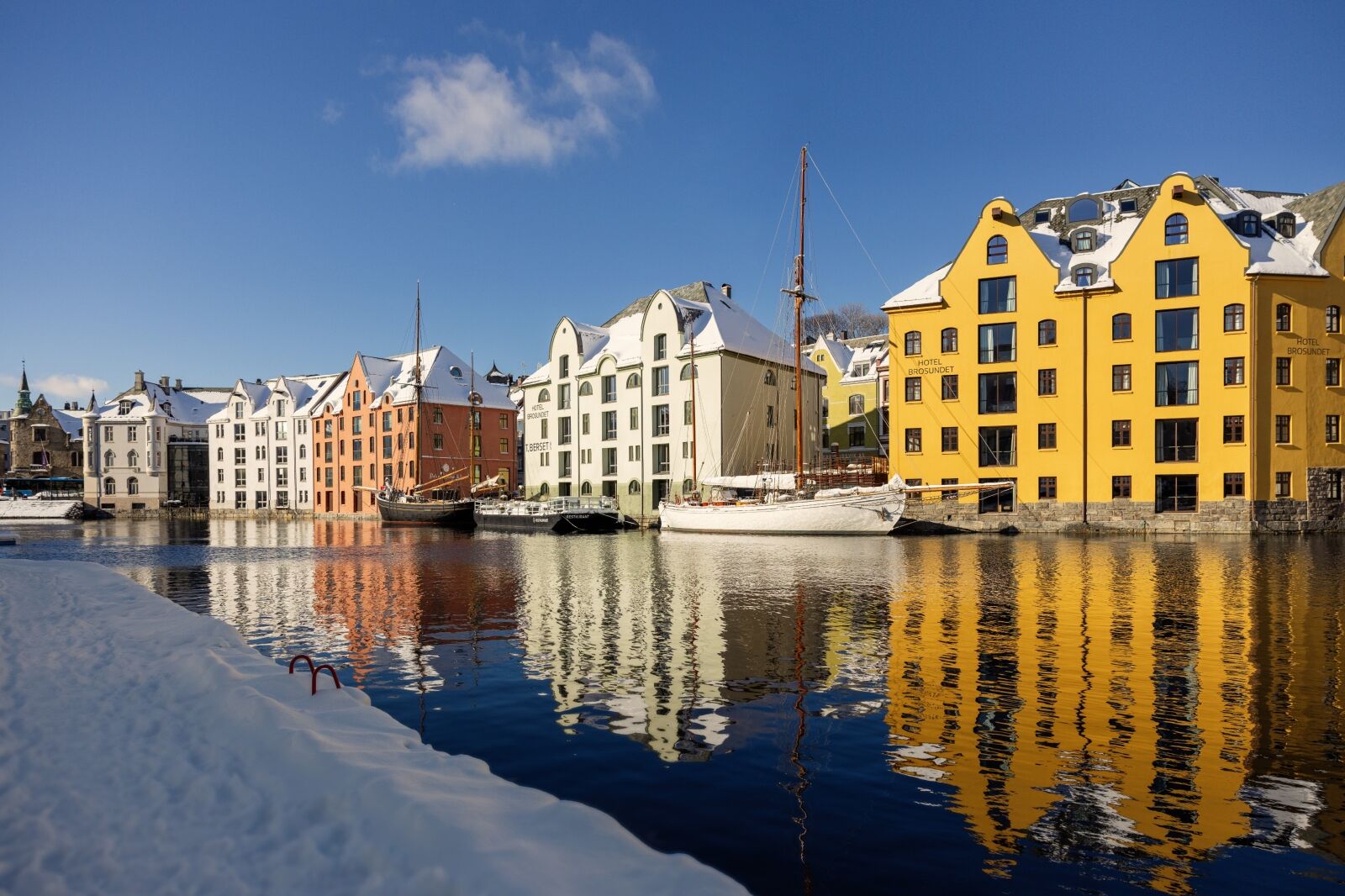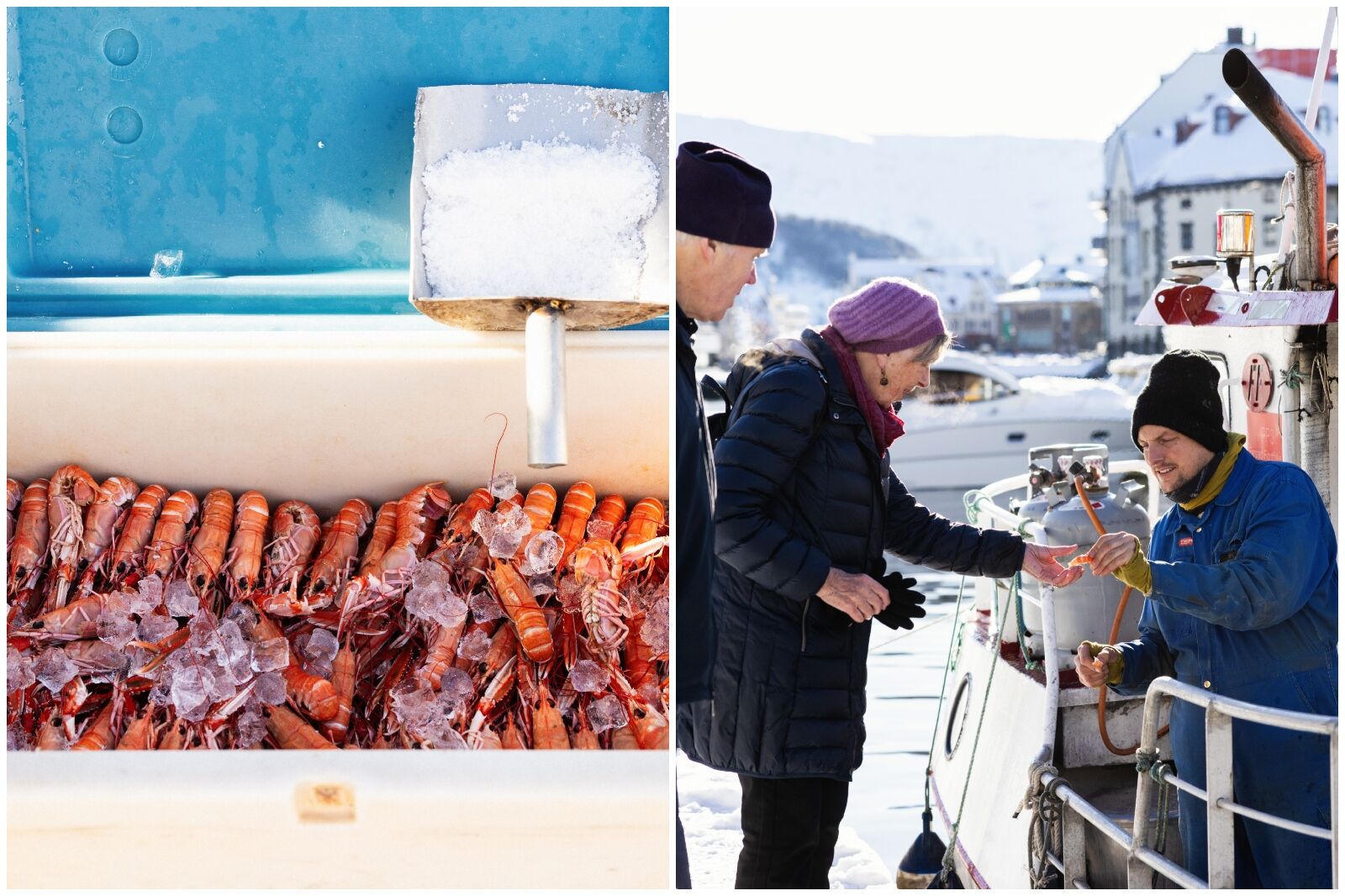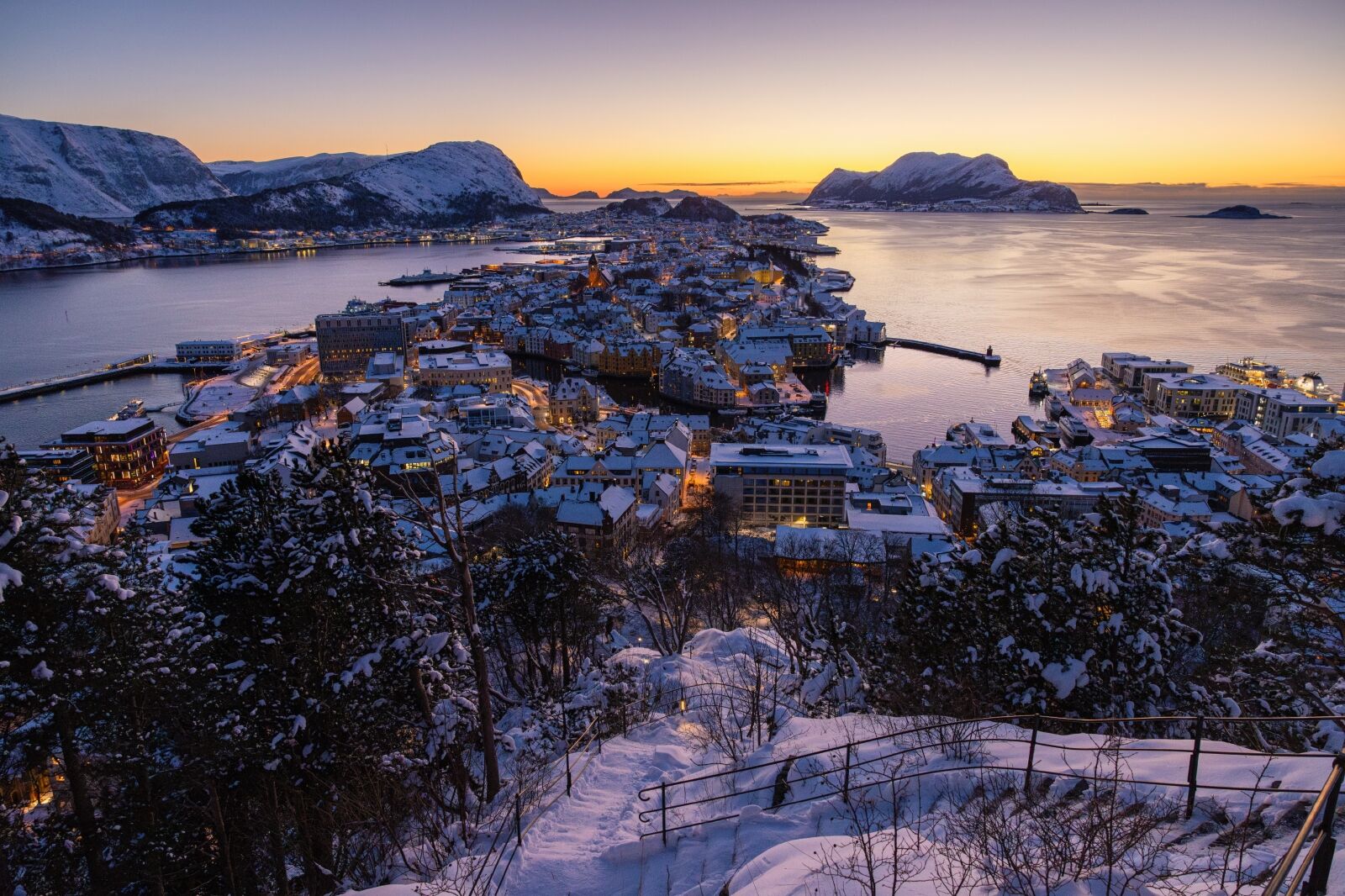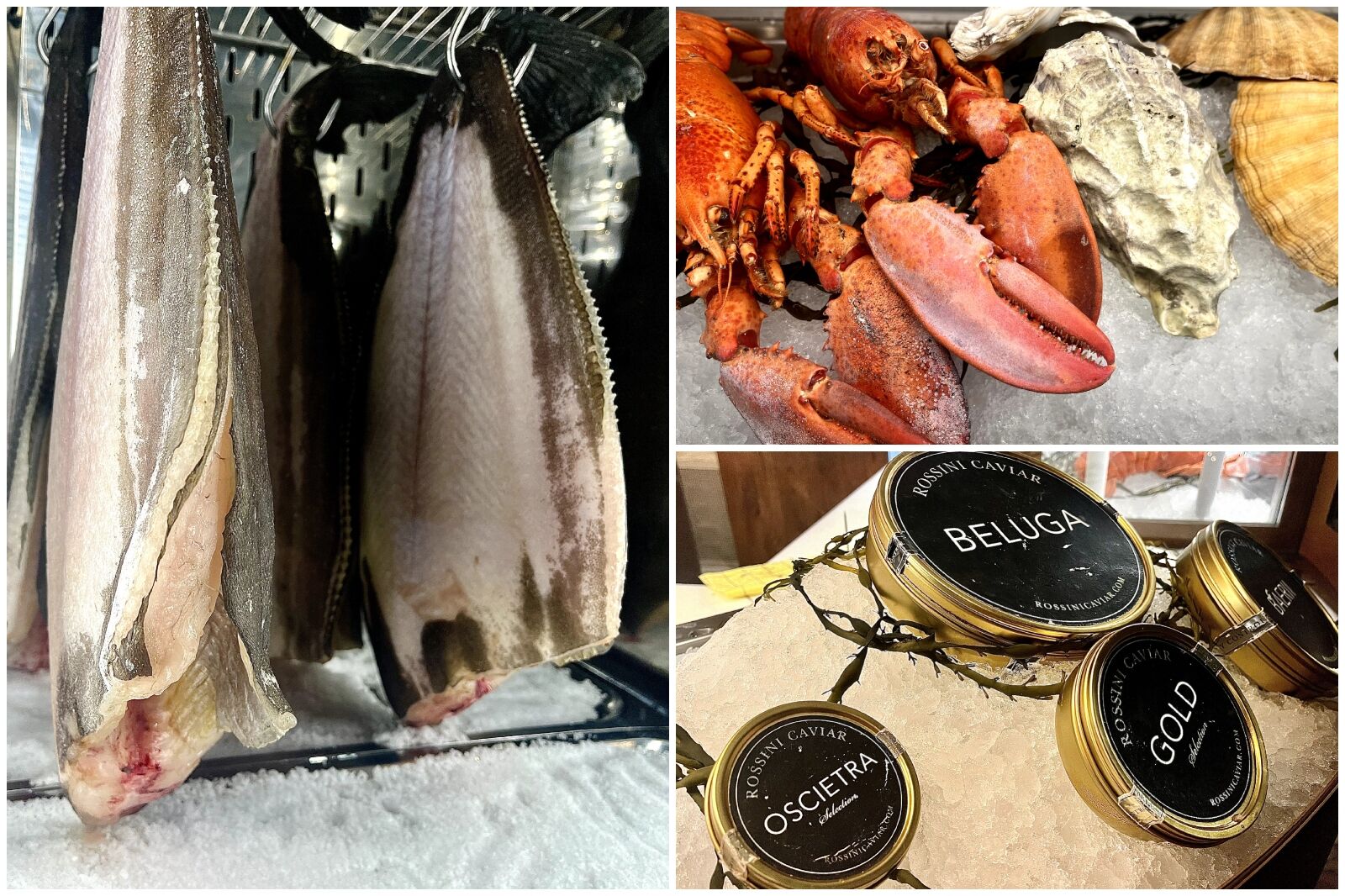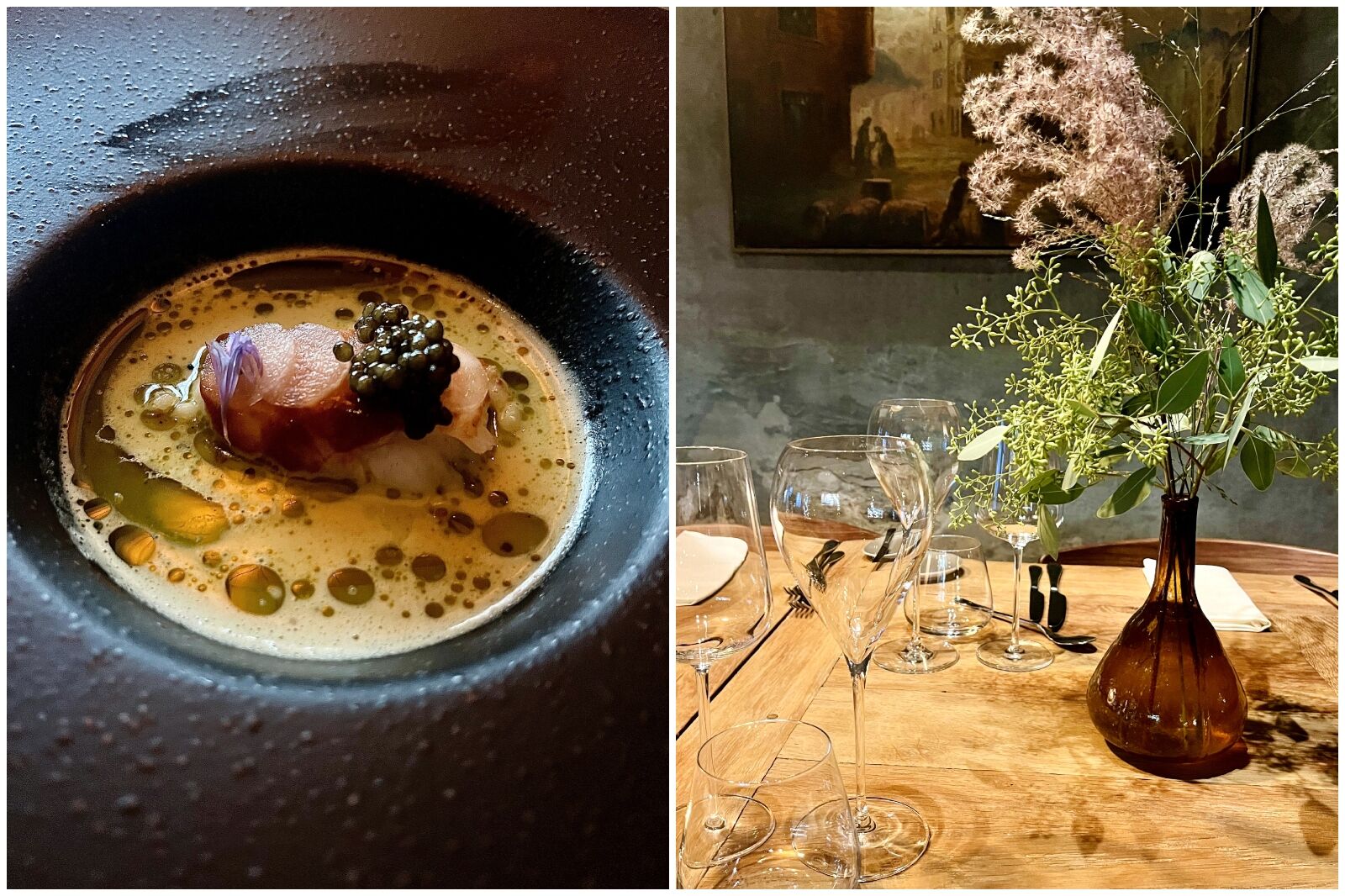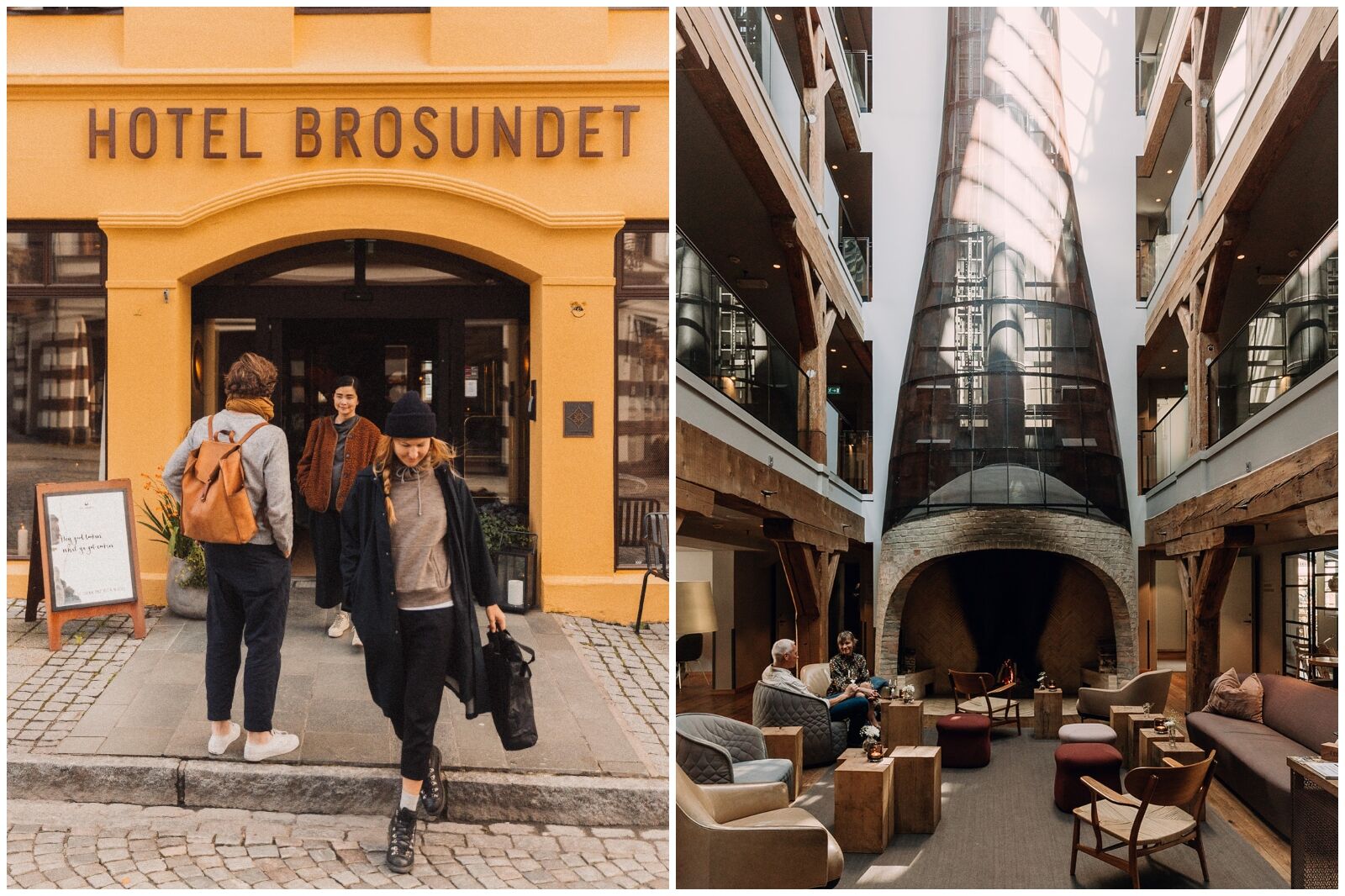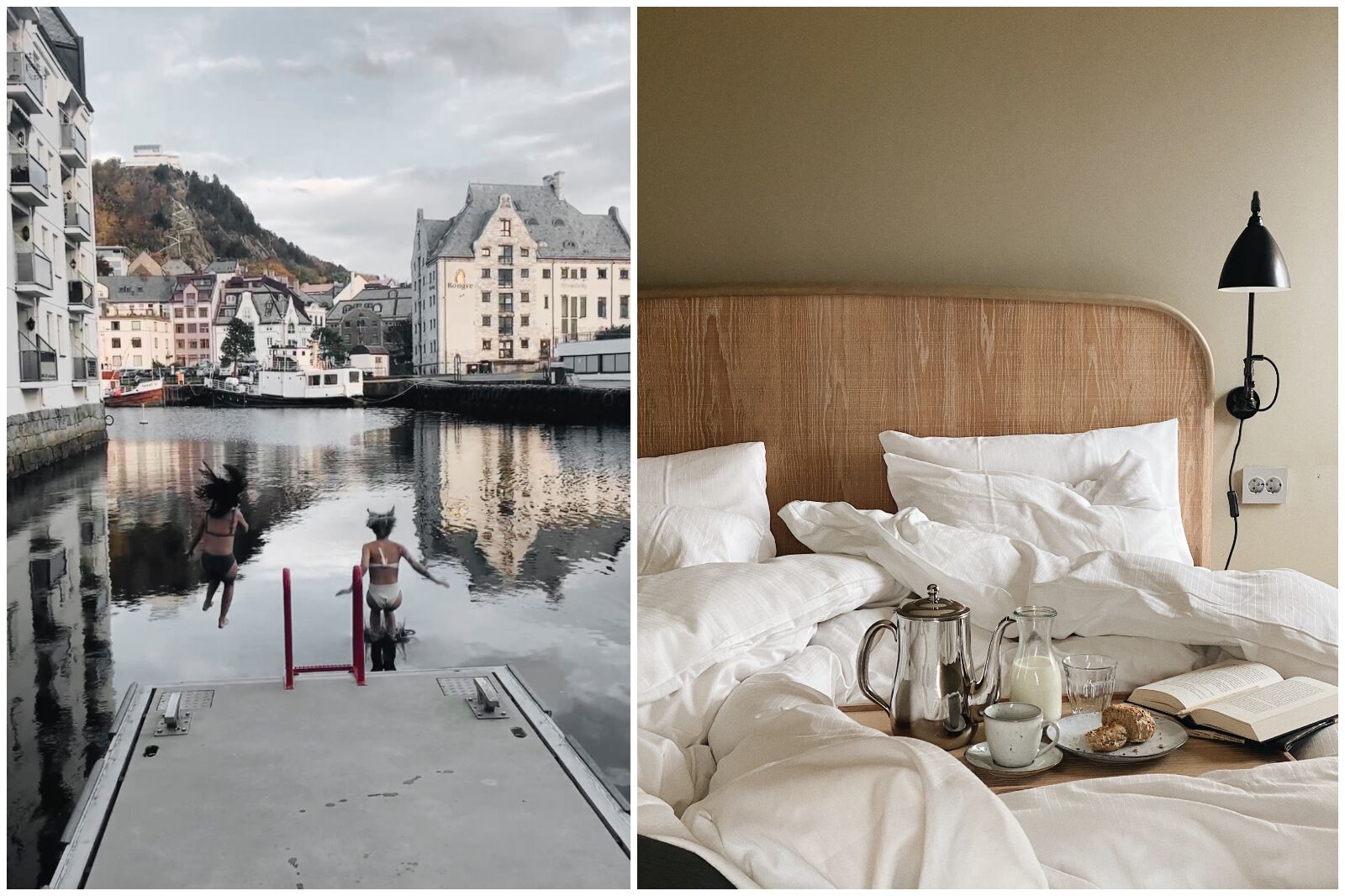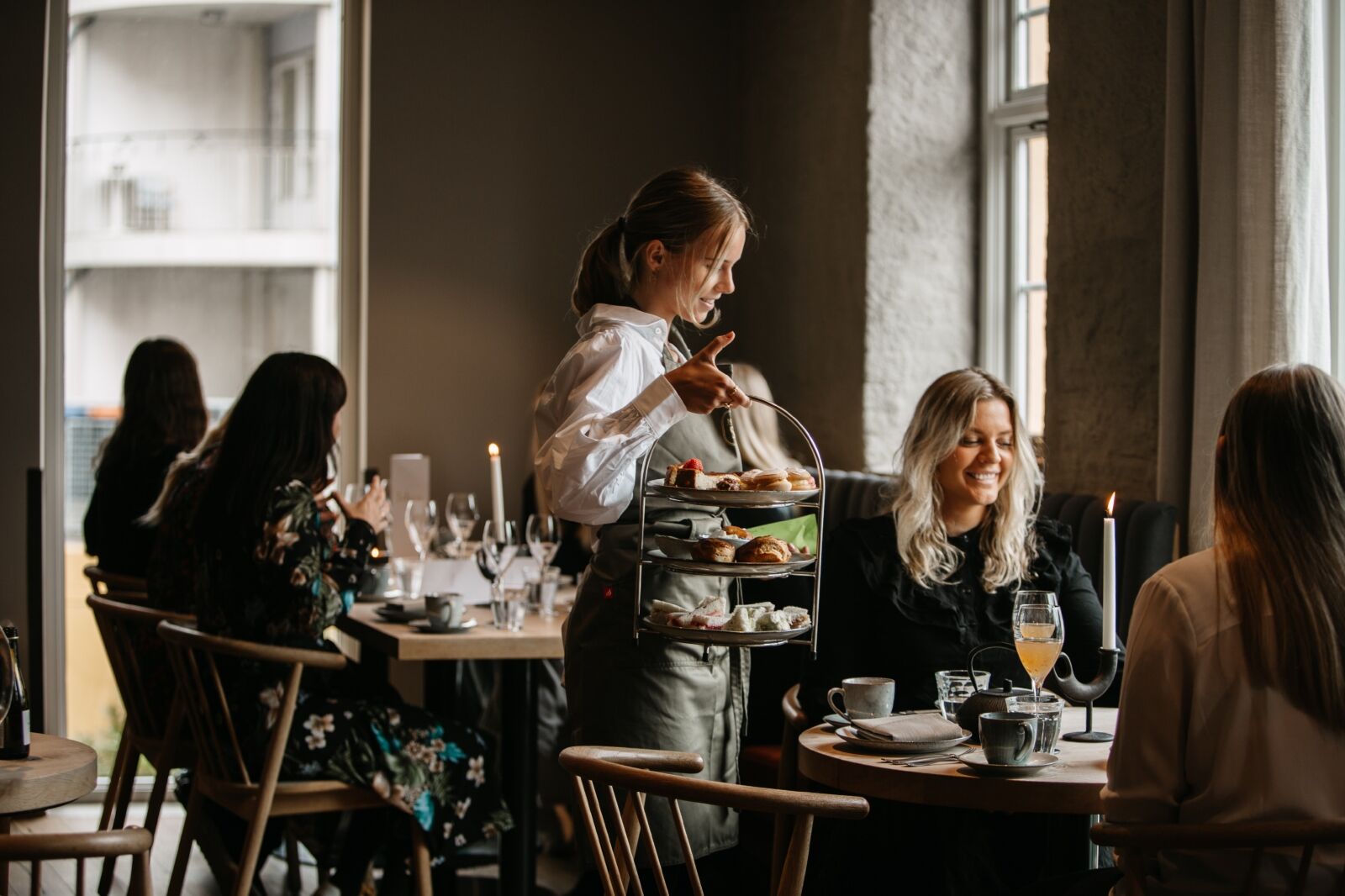The northern section of Fjord Norway, along the upper west coast, is home to some of the country’s most stunning fjords and mountains. It’s dotted with picturesque fishing towns and villages, and fish are central to the region’s culture, economy, and culinary heritage. Inland, bountiful, sun-drenched farmlands surrounding the fjords are defined by family-run fruit and dairy farms. All of this makes for exceptional restaurants helmed by chefs who honor local ingredients. And it’s a food scene best enjoyed on a road trip.
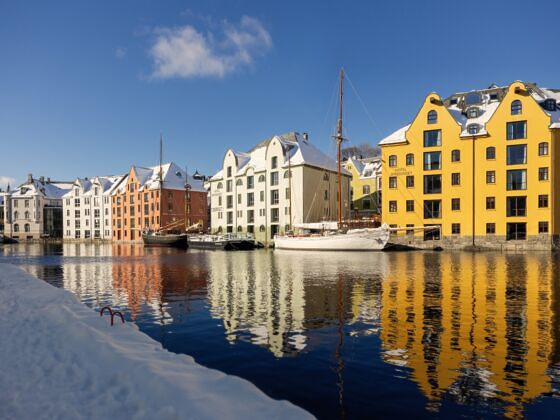

Eat Your Way Around Northwest Norway on This One-Week Culinary Road Trip
From the home of klippfisk (salted and dried cod) to the Art Nouveau streets of Ålesund, the route includes stops at orchards, a dairy farm making award-winning cheese, and one of the prettiest chocolate factories on Earth. While food is the highlight, it’s not all there is to experience in this cherished part of Norway — between meals there’s the UNESCO World Heritage site of Geirangerfjord and the famous Atlantic Road.
Kristiansund
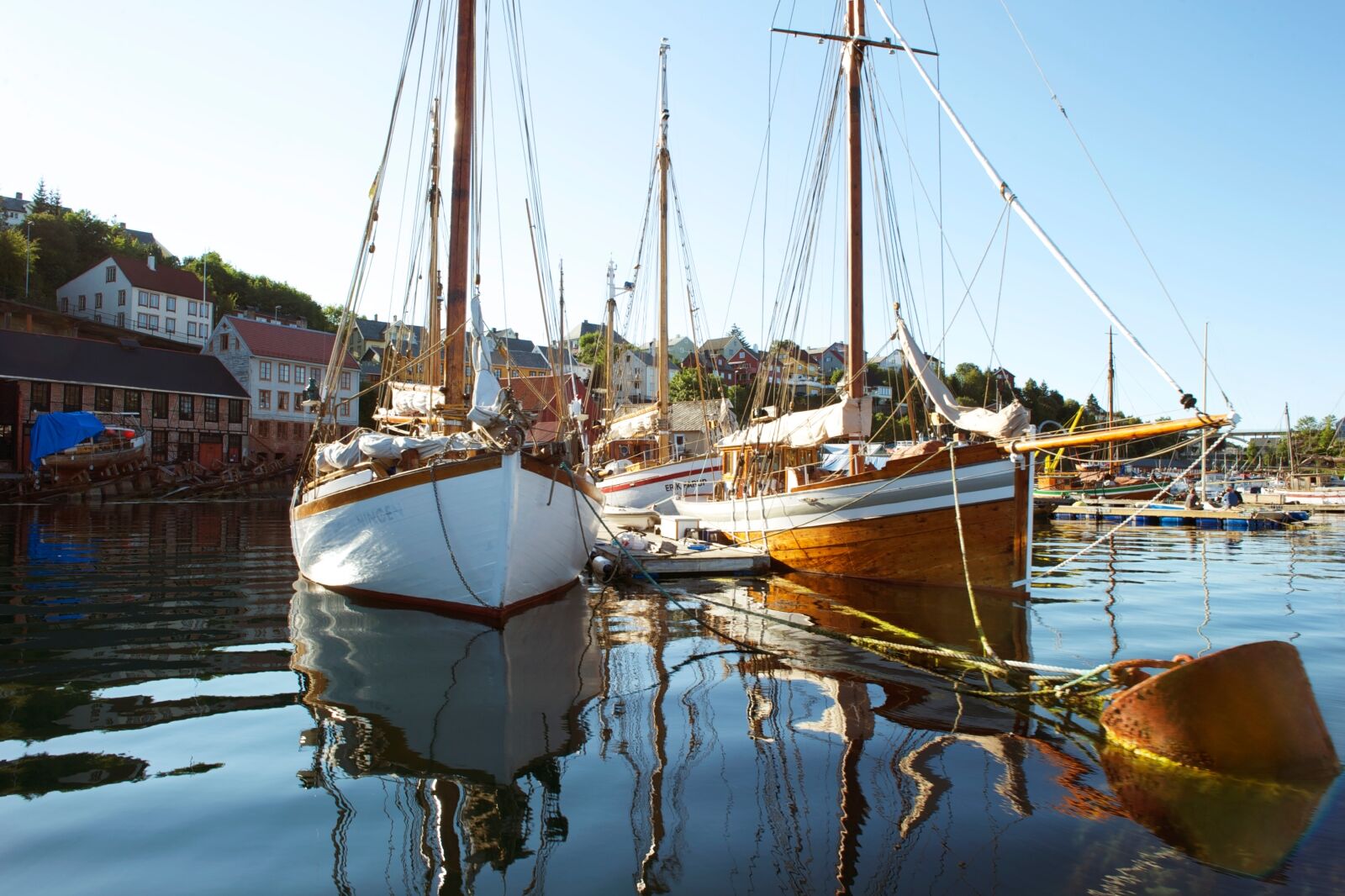
Photo: Visit Northwest/Johan Wildhagen Paolookaville
Start in Kristiansund, a coastal town known for its scenic archipelago, hospitality, and delicious seafood. The town covers four islands connected by the Sundbåten, a free ferry service that has run since 1876. It’s one of the oldest public transport systems still in operation in the world. Take a guided tour on the Sundbåten for a better understanding of the area, its history, and layout. Plus, it’s a lovely way to travel around the different islands — especially on a crisp sunny morning.
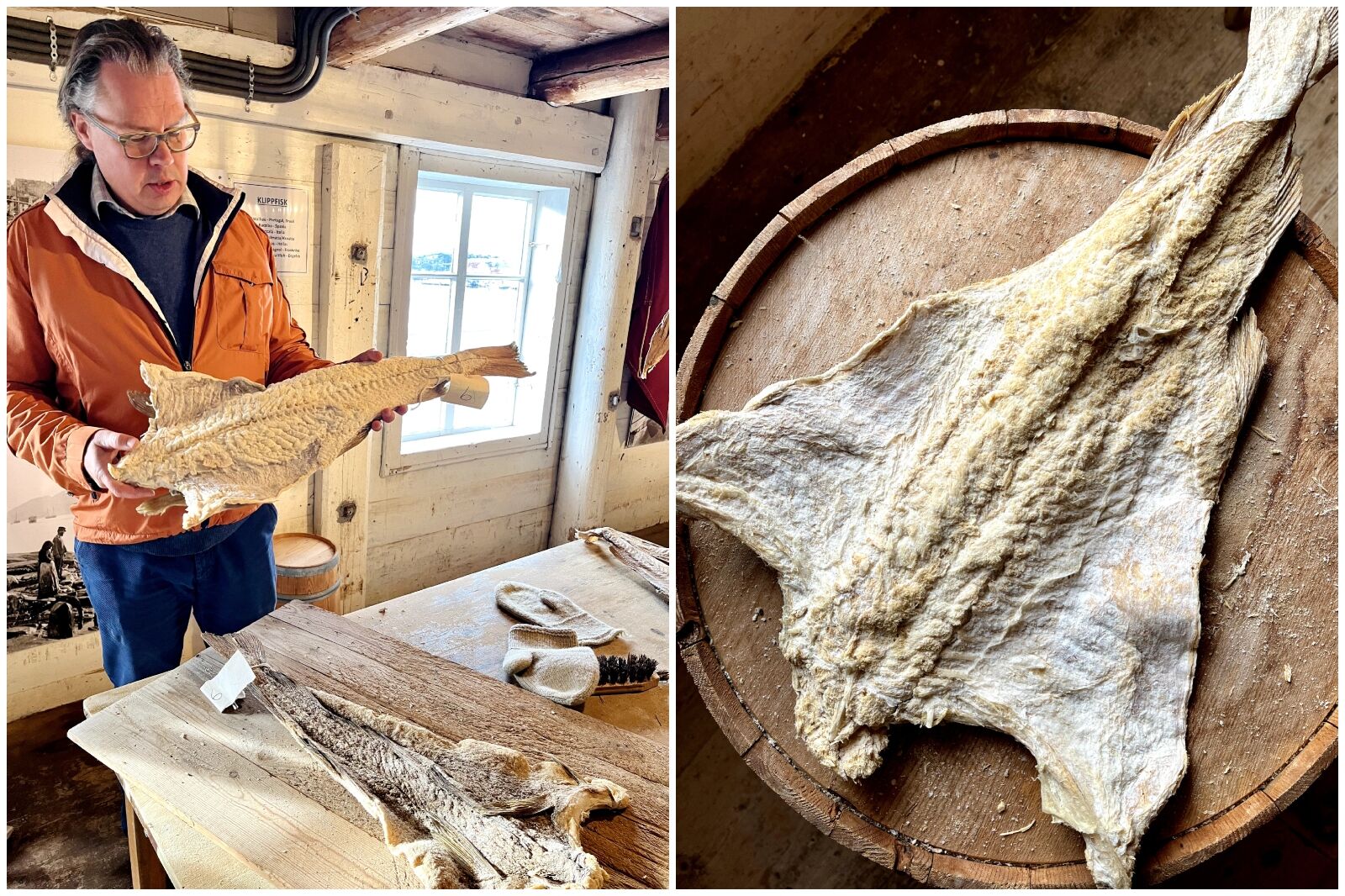
Photo: Katie Scott Aiton
Kristiansund’s heritage is deeply intertwined with the fishing industry, specifically the production of klippfisk. This traditional Norwegian dried cod is made by splitting the fish along its backbone, salting it heavily, and then drying it. Historically, the drying was done naturally in the open air on stone or wooden racks placed on cliffs or other exposed areas (hence the name, which roughly translates to “cliff fish”). With its cold, dry winds, the Norwegian climate is ideal for this preservation technique. The city’s location, harbors, and access to excellent fishing grounds helped klippfisk become a major part of the local economy. During the 18th and 19th centuries, Kristiansund experienced rapid growth, fueled by the export of klippfisk to countries across Europe, the Caribbean, and South America, where it’s called bacalao and remains a staple today. A must-visit to understand this history is the Norwegian Clipfish Museum, where you can take a guided tour through the historic 1749 wharf on the island of Gomalandet.
Where to eat in Kristiansund
Smia
This charming harbor-side restaurant’s building has had many lives. The little red wooden structure has been a boat house, a blacksmith workshop, and a dress-making shop. “We don’t really know how old the house is,” says Stian Røsand, head chef, “but it was moved here in 1786.” The restaurant opened in 1994. Renovations have been made, but there are nods to the past that respect the fascinating history of the establishment.
Smia celebrates fish. Meat makes an appearance on the menu, but as it’s in Kristansund, it’s fitting to eat local fish dish.
“Most people come here for bacalao, so we can never take it off the menu,” Røsand says.
In Norway, bacalao refers to more than just the fish itself: it’s a hearty stew made with a tomato base and klippfisk, onions, potatoes, and peppers that add a kick. A house speciality is bacaolao de grip lighthouse. This colorful dish comes in three bowls of red, green, and white bacalao (colors of the lighthouse). The white dish is made with a local Italian-style sausage, the green with ramsløk (wild garlic), and the traditional red with a tomato base.
Klippfisk as its own highlight will always have a place on the menu, too. The klippfisk at Smia is skrei cod, a North Atlantic migrating cod from farther north near Lofoten that’s larger than those found in the fjords around Kristiansund. By keeping it simple, Røsand shares, the hearty dish is similar to what his grandmother would have served. It comes with mashed potatoes, bacon, carrots, and swedes (rutabaga.) Perhaps it was the warmth of Smia’s open fire, the wonderful hospitality, or the food itself, but while eating this I had the comforting thought of my own grandmother.
Smia: Fosnagata 30B6509 Kristiansund, Norway
Bryggekanten Brasserie
For lunch with a view, reserve a window seat at Bryggekanten Brasserie across the harbor from Smia. With a backdrop of the water, you can sit and watch locals coming and going on the ferry. The vista from this pier-positioned restaurant is breathtaking, and the food is exceptional. I enjoyed seared scallops from Hitra (a delicacy from the islands of Hitra and Frøya just north of Kristiansund) with beurre blanc, roe, grilled salmon, pickled squash, sunchoke chips, and dill mayo. This was followed by lamb two ways with glazed carrot puree and a delicious hazelnut cream paired with a glass of the famed pink apple juice by Fjordsider, a cider and juice company from the picturesque Romsdal Peninsula of Norway.
Bryggekanten Brasserie: Storkaia 1, 6509 Kristiansund, Norway
Where to stay: Thon Hotel Kristiansund
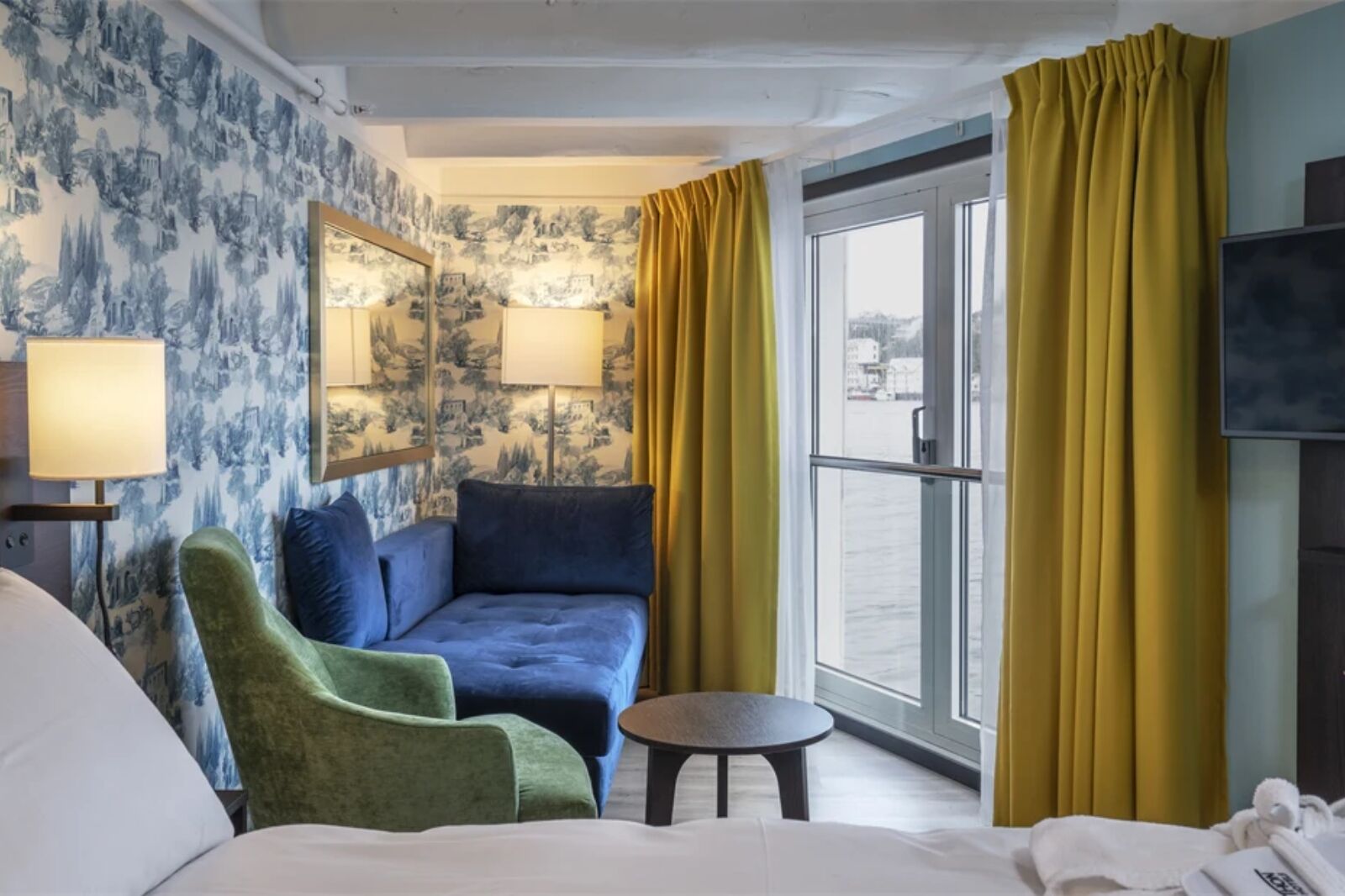
Photo: Thon Hotels
Thon is a chain through Norway, Sweden, and Denmark. I’ve stayed at many throughout my travels in the region and highly recommend a night or two at Thon Hotel Kristiansund. Ask for a room with a harbor view, and you’ll wake to expansive windows that almost feel like you’re standing above the water. Rooms are responsibly priced, comfortable, and have everything you need (an iron, coffee machine, large beds). The service is also excellent.
Thon Hotel Kristiansund: Fiskergata 12, 6507 Kristiansund, Norway
Tingvoll
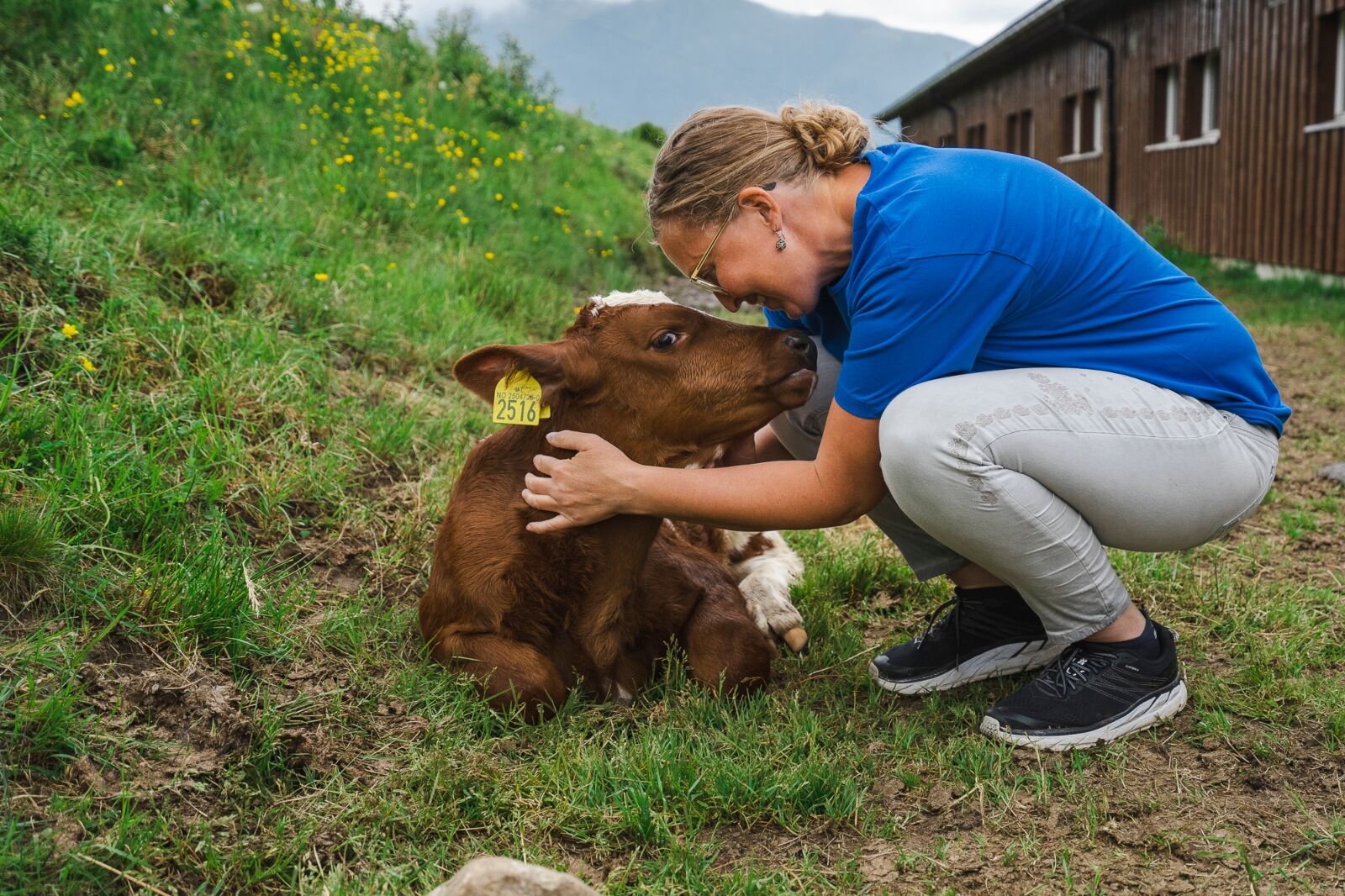
Photo: Visit Northwest/Eline Karlsdatter Fladseth
From Kristiansund, drive one hour through the countryside — peppered with red timber houses, old tractors, and farms — until you reach the village of Tingvoll in Møre og Romsdal county. Fifteen minutes from Tingvoll is the family-run dairy farm Tingvollost, where you can taste (and purchase) award-winning cheeses.
Here, I met Kristin Waagen, whose family has been making cheese since the early 2000s. Waagen shared stories of making cheese for the first time in the farmhouse bathroom, and how she expanded the business and won the World Champion in World Cheese Awards in 2016 for Tingvollost’s Kraftkar blue cheese (not to mention other national awards).
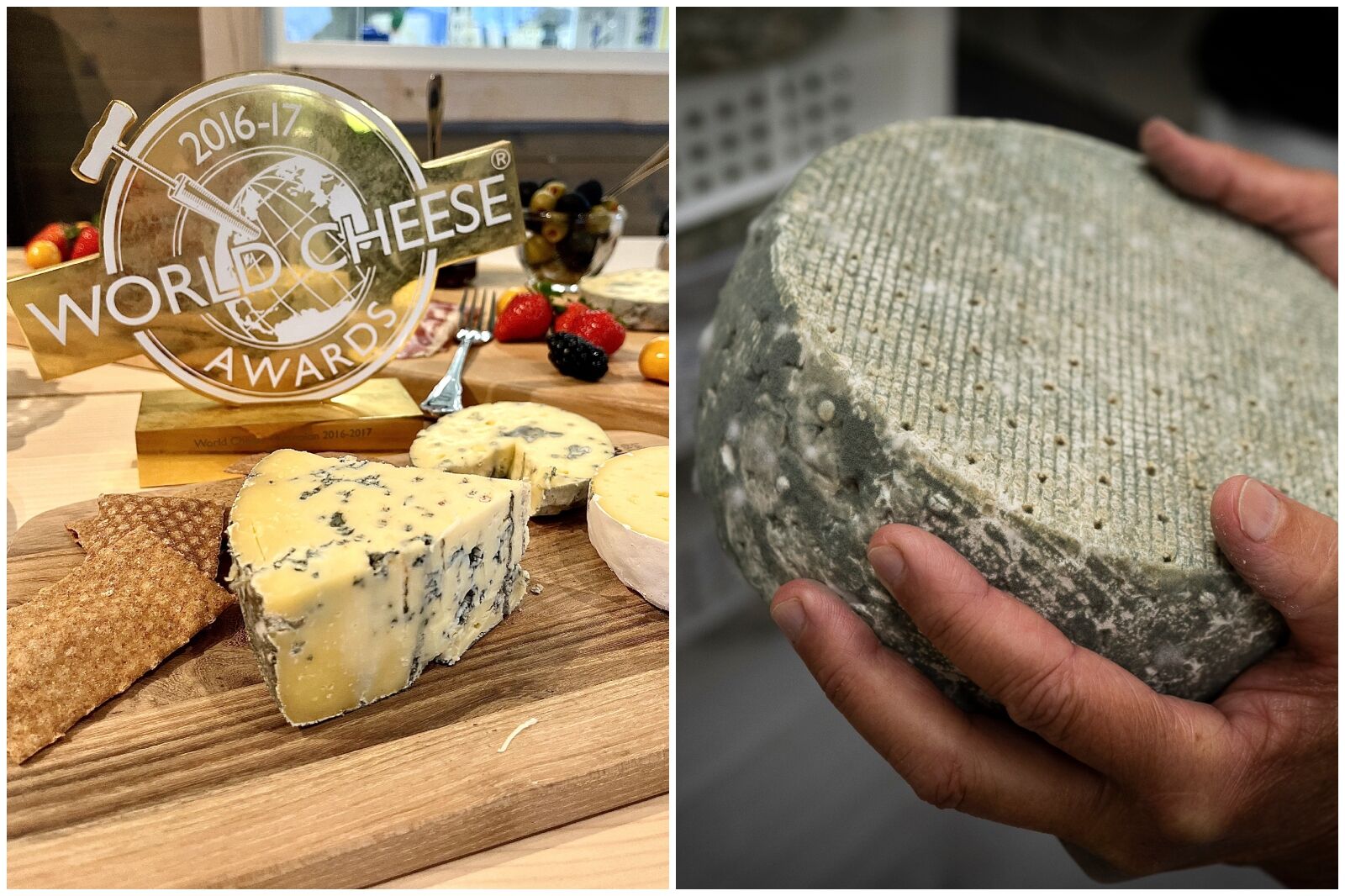
Photo: Katie Scott Aiton, Visit Northwest/Eline Karlsdatter Fladseth
“The way we handle the cows has a lot to do with the taste of the milk,” Waagen says, explaining the dairy’s success as multifaceted. The cows are respectfully given room to roam. Each has its own personality and name, like Ariana Grande (named by her daughter), Fagerli (an old Norweigan name), and Kokos (Norweigan for coconut). “The cows are my friends,” Waagen says with an infectious smile. A life without stress, Waggan remarks, produces the finest dairy, and everyone, including the cows, has a happy life. Despite the success and awards, or perhaps thanks to them, Tingvollost plans to stay at its current production size to retain product quality and keep up with the beneficial animal condiditions.
You can spend a few hours here. If you visit in summer, there are cute outdoor playhouses for kids. Inside the farm shop, you can purchase the mouth-watering, award-winning blue Kraftkar, along with Edel Frue, a mild and sweetish soft cheese, and the nutty, semi-hard Mild Mester.
After indulging in cheese, you’ll need something to wet your whistle, so drive 25 minutes onto Tingvoll Sider. Sider (cider in Norweign) production in Norway has grown exponentially since popularity started to rise in the early 2010s. The apple juice and cider I tasted here was the finest I’ve had.
Tingvoll Sider is run by Silje Osnes. The orchard and brewery have only been in operation since 2020, but what started as a hobby with 250 trees quickly became a full-time job for Osnes, an ex-school teacher. Tingvoll Sider has already made serious waves on the international drinks scene, winning two medals in the International Cider Awards and selling out every year. Osnes says she sent a bottle of her cider into the competition in the first year of production simply to get feedback. Little did she know quite how successful she would be, ending up with a silver and bronze and two more awards the following year. Today, the farm has over 2,000 trees producing pesticide-free, old apple varieties.
Osnes is humble when talking about her success, and notes that she’s still learning and loves to collaborate with other experts and breweries in the country. That said, Osnes believes in her product. I enjoyed a few of the ciders: Hustru Gyrid; Strupstadsider; and Sval, the non-alcoholic cider. You can taste the love in every sip. Sealing bottles by hand, Osnes works exceedingly hard to keep up with demand. One of my favorite tipples was the dessert apple wine I drank in the beautiful, light-drenched summer house on the property. Surrounded by baby apple trees, I indulged in a slice of house-made sour cream apple cake with a view over Strupstad farm and on to Breifjorden and Trollheimen.
Hustadvika via the Atlantic Road
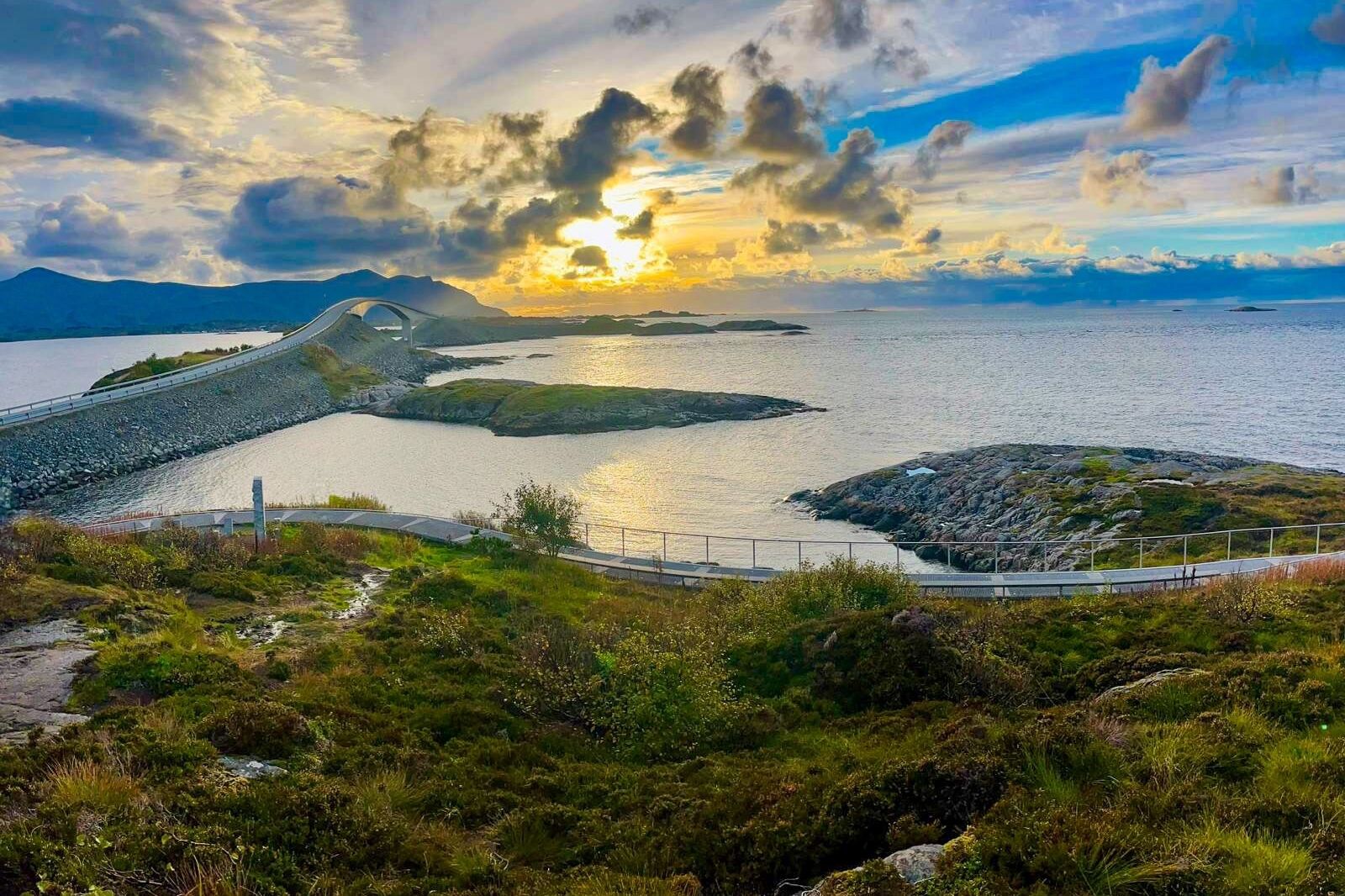
Photo: Katie Scott Aiton
You can take your cheese and bottles of cider to your accommodation and call it a day in Tingvoll. If you’re tight for time, jump back behind the wheel and drive toward one of the most famous roads in the world: the Atlantic Road. One of the 18 Norwegian Scenic Routes, this beautiful drive from Tingvoll will get you to the famed Storseisundet Bridge in about an hour and a half. There are multiple stopping points for photos or to sit on the hillside and watch the cars dip over the bridge’s crest and onto the mountains.
I was fortunate on this cold fall day that the weather was behaving, but because it can be unpredictable, stay close by just in case you need to nip back the following day for the view.
Where to stay: Hustadvika Havhotell

Photo: Classic Norway Hotels
Situated by the coast, Hustadvika Havhotell is a hotel you won’t forget in a hurry. The location feels like the end of the Earth, with views of neighboring mountains and the Norwegian Sea. A pier jots out from the building housing the hotel’s rooms and suites where you can jump off for a morning swim — after an on-site sauna, of course — and there’s a handful of small cabins on the property with a small kitchenette for groups and families. But you might not want to cook. The turf-covered main building houses the restaurant, which you can stroll to from your accommodation. The multi-course tasting menu here champions produce from within a very small radius. The food is excellent, as is the hospitality, making this another place you might find hard to leave.
Hustadvika Havhotell: Storholmvegen 90, 6444 Farstad, Norway
Bud
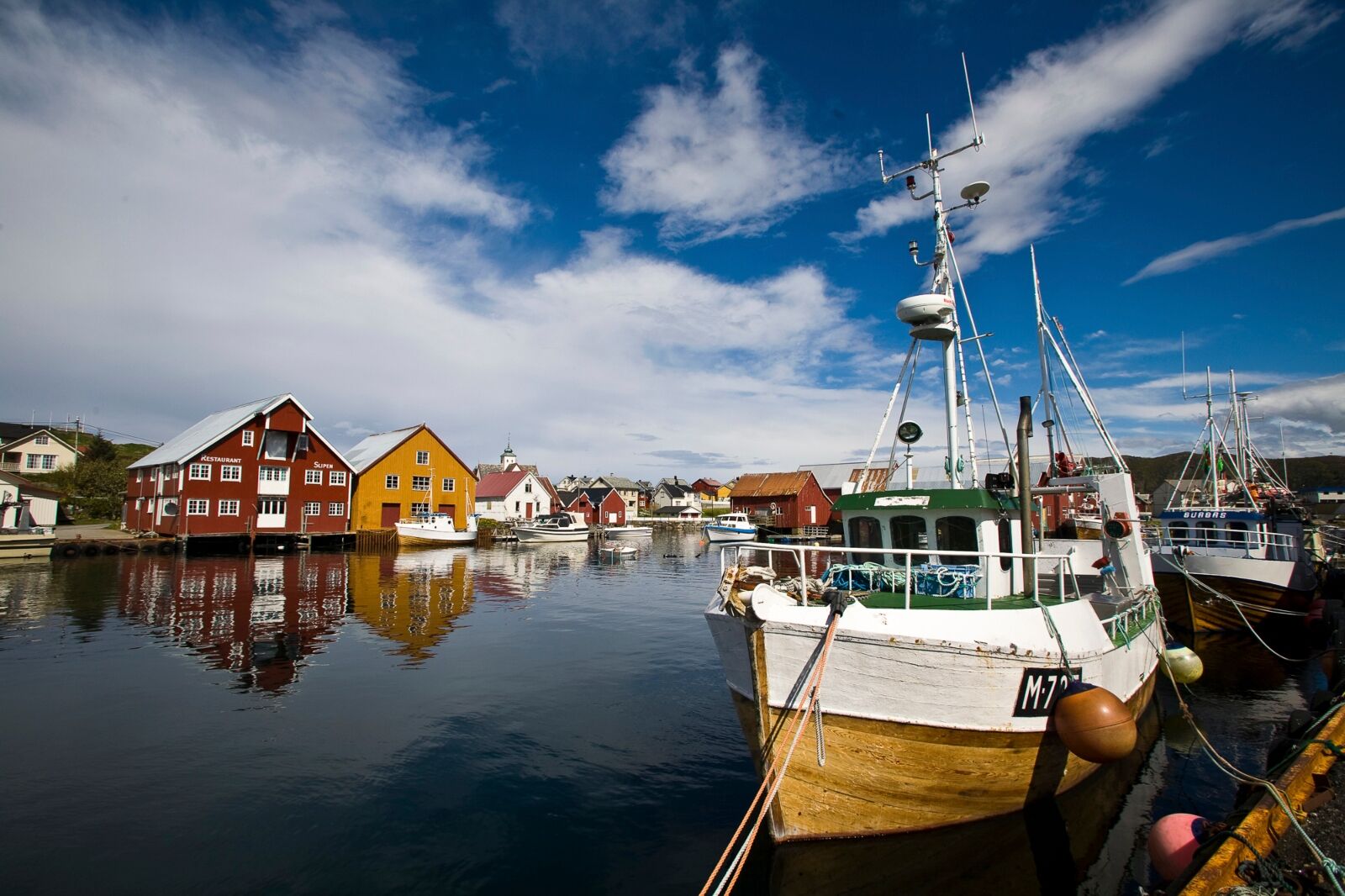
Photo: Visit Northwest/Einar Engdal
The fishing village of Bud is a 15 minute drive from Hustadvika Havhotell, and you can stop along the way for a scenic walk on the beach and to build up an appetite for lunch. Bud is home to Ergan Coastal Fort, which was built and used during World War II by the Nazis and those who fell under their control. Today, you can see remnants of the holding and go on a tour. It also offers cracking views down the coast and over the village of Bud and its colorful timber-clad buildings. You can walk down the hill to reach the restaurant Slipen on the harbor side, and it’s here you’ll have one of the best meals in the region.
Where to eat in Bud
Slipen
Slipen is owned and operated by Rune Skeide, a towering man who speaks passionately about the establishment. The building went up in 1890. Skeide shares that it was originally used to offload and store fish in the cellar — hence the name “Slipen,” referring to the slip the boats would use. Skeide opened Slipen in June 2024 and runs an exceptional restaurant upstairs and a bar below.
Slipen focuses on using local ingredients. I ate venison carpaccio, which was hunted five minutes from Bud. Skeide hopes to be nose-to-tail with a butchery downstairs in the future. The main course was wild halibut, caught just off the shore. The story behind each dish only adds to the eating experience. Skeide’s cooking is flawless. Dishes are comforting yet complex, showcasing the skill of balancing flavor and making sure the star of the plate is not lost in pretentious sauces or unnecessary ingredients.
Slipen: Vikavegen 67, 6430 Bud, Norway
Valldal
From Bud, it’s a three-or-so-hour journey to the next stop, Valldal, a valley in the Fjord Municipality in Møre og Romsdal county that’s known for its outdoor activities and superb fruit-growing conditions. The drive includes a 30-minute ferry from Molde to Vestnes over the Moldefjord. Understandably, ferries are a popular mode of transport in this region. They are efficient, clean, and allow you to stretch your legs and enjoy the water views. Before checking in at Valldal Fjord Hotel, make a beeline for Lingebakken, a family-run fruit, cider, and juice farm. There’s a farm shop where you can pick up a bottle or two of Bakkesider, a delicious spontaneously fermented cider.
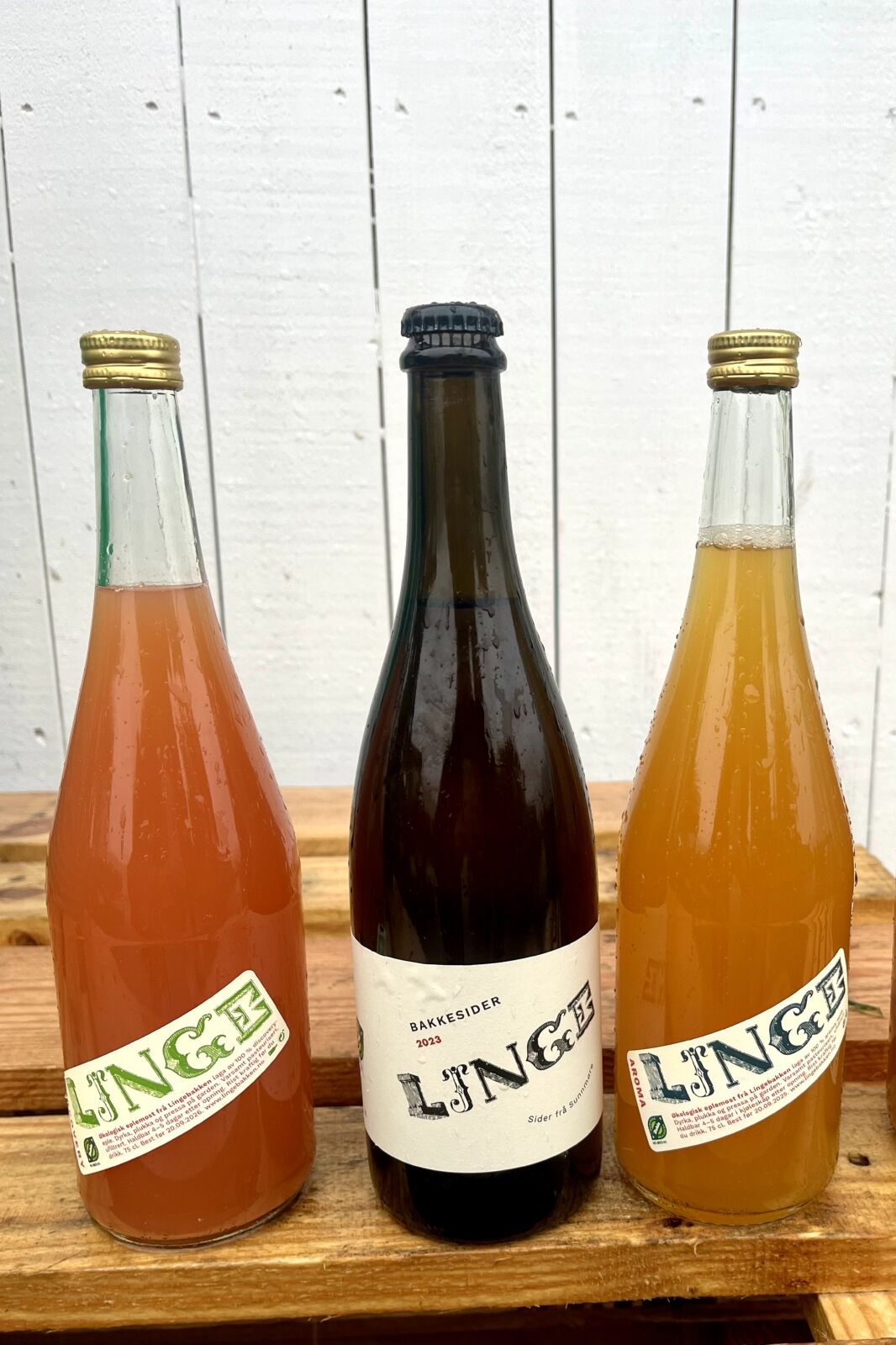
Photo: Katie Scott Aiton
The south-facing farm benefits from the sun, and the climate is excellent for growing sweet cherries, sour cherries, plums, apples, and pears. The owner, Elida Linge, is the sixth generation working the land and can organize private tours if you are visiting outside of the July to October fruit season.
Where to stay: Valldal Fjord Hotel
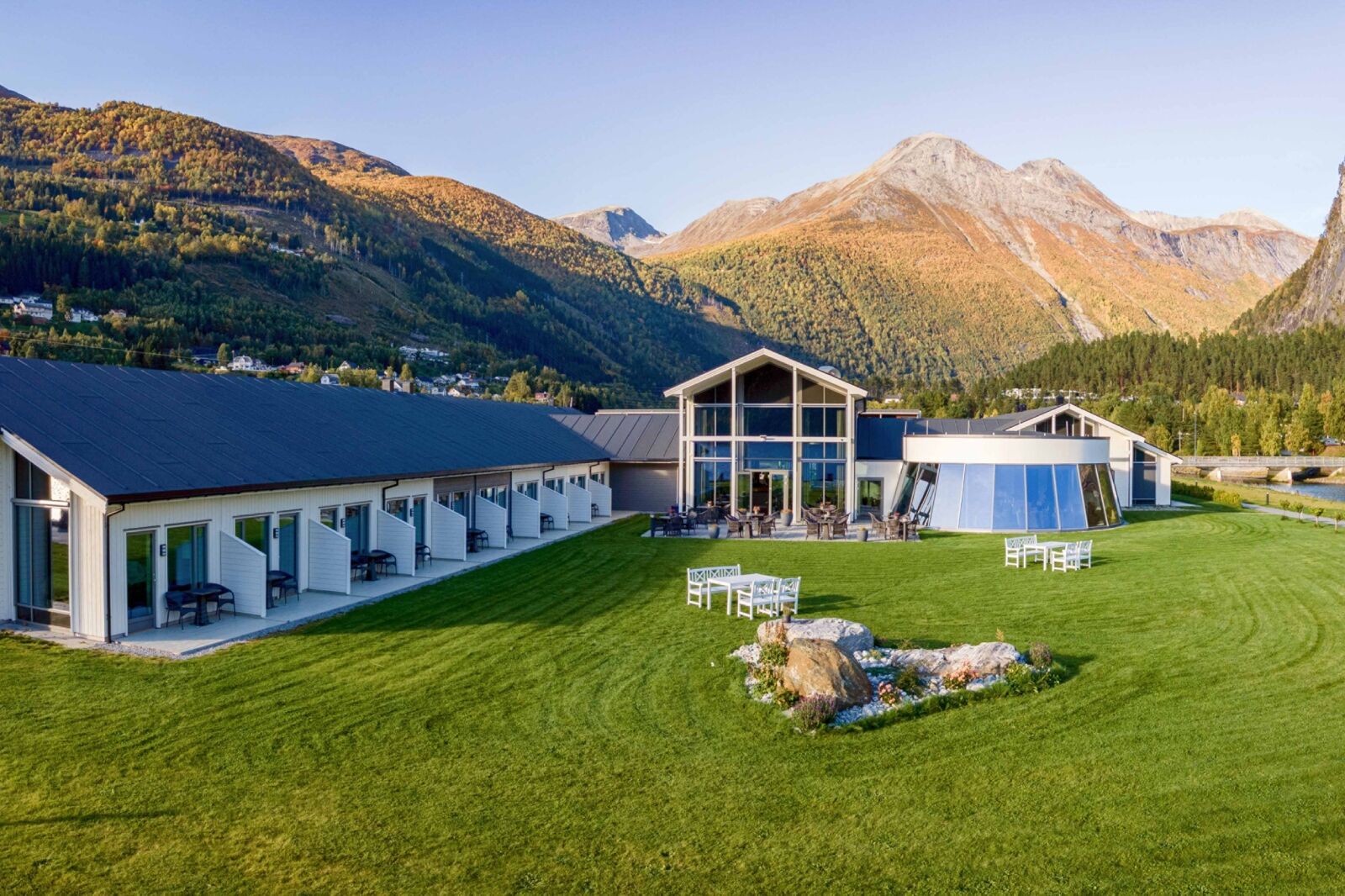
Photo: Valldal Fjordhotell
Valldal Fjord Hotel is another accommodation with a very good restaurant — a theme I’ve appreciated this trip. After a day of driving and exploring, you can rest assured you’ll get taken care of at dinner. In addition to the dining, there’s the jaw-dropping view over the Norddalsfjord and onto the looming mountains from the glass-fronted dining room and lounge from the French doors and private terrace of your room. Snow draped the mountain tops when I visited in September, and sitting by the water with a morning cup of coffee was one of the most cherished moments on this route.
Valldal Fjord Hotel: Grandegata 30, 6210 Sylte, Norway
Geiranger
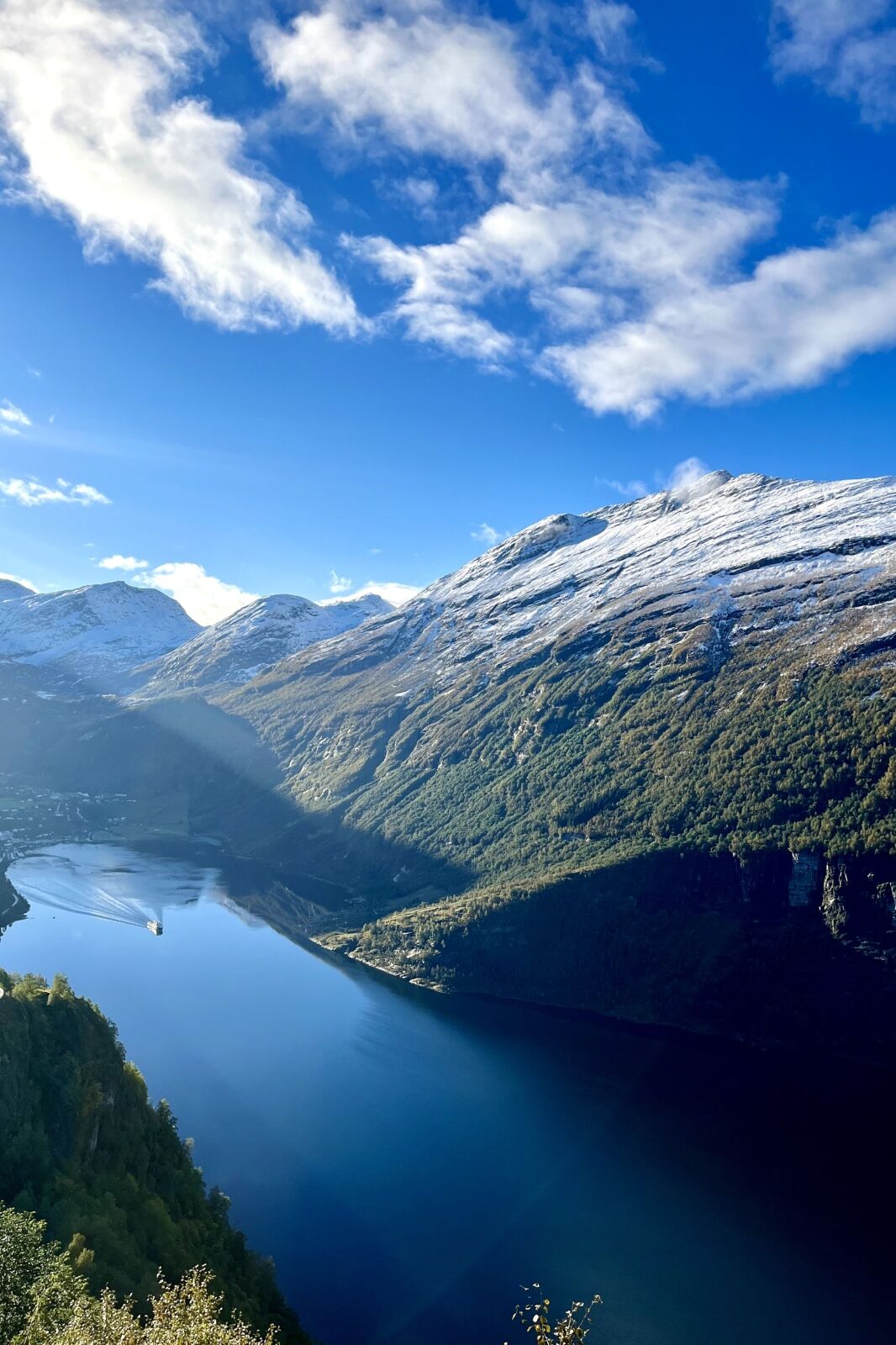
Photo: Katie Scott Aiton
From Valldal, you’re in for one hell of a drive through the UNESCO World Heritage site Geirangerfjord. This route includes Eagle Road, a thrilling stretch with hairpin bends skirting the mountainside. Stop at Ørnesvingen, the highest of these hairpins, and take in the view of all views over Geiranger and the Geirangerfjord.
Geiranger village is situated at the head of the Geirangerfjord. The fjord stretches for approximately 15 kilometers and is hugged by steep, towering mountains that plunge directly into the water. If time permits, consider staying in Geiranger for the night; if not, make time to saunter through the village and stop at local shops such as the chocolate factory, Geiranger Sjokolade.
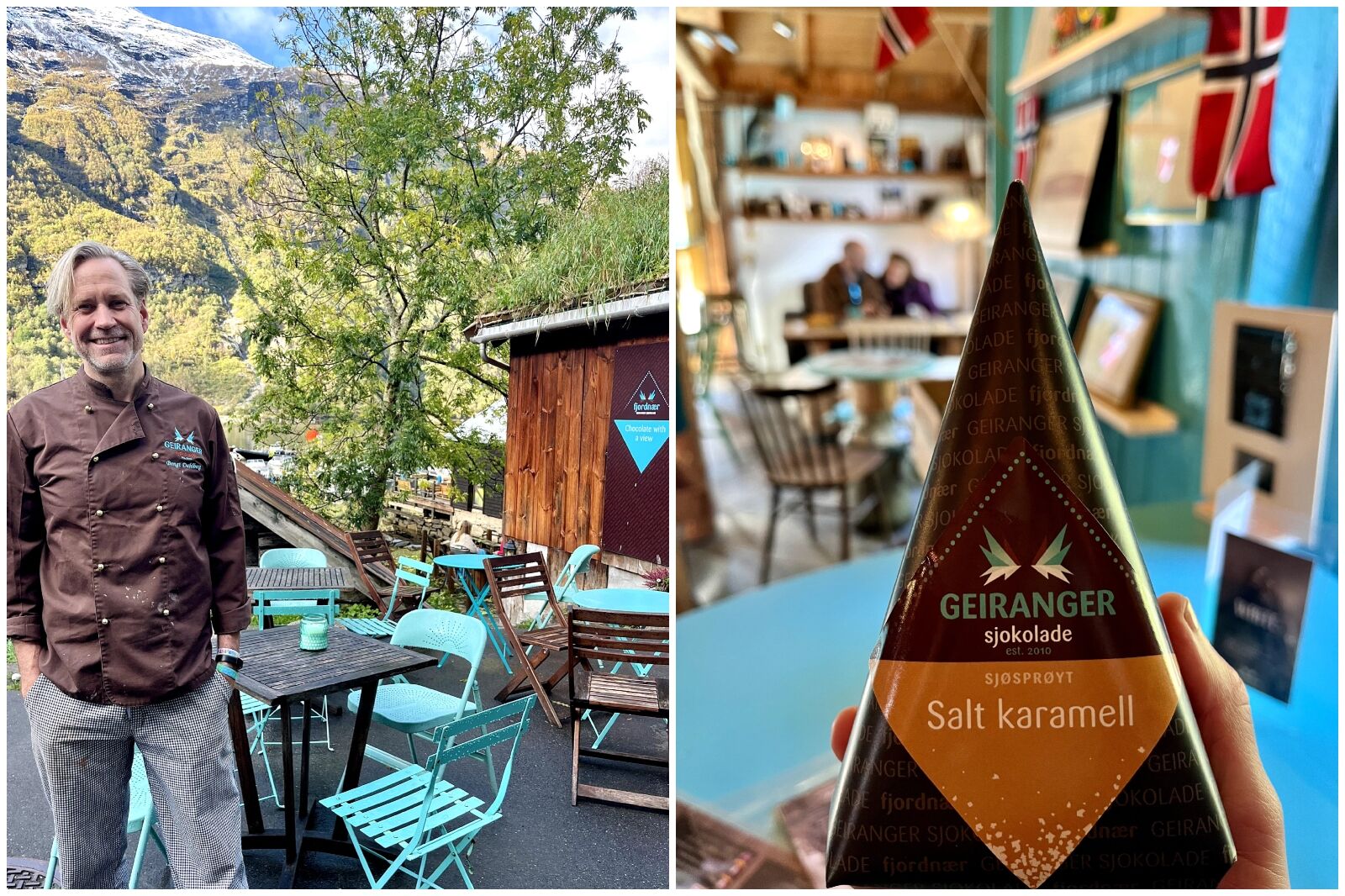
Photo: Katie Scott Aiton
Here, Swedish-born Bengt Dahlberg crafts delicacies such as the chocolatier’s Academy of Chocolate Awards-winning blue cheese, brown cheese, and whiskey bonbons. Take the opportunity to purchase a box or two for loved ones, and indulge in a chili-spiced hot chocolate if the mood takes you.
Where to eat in Geiranger
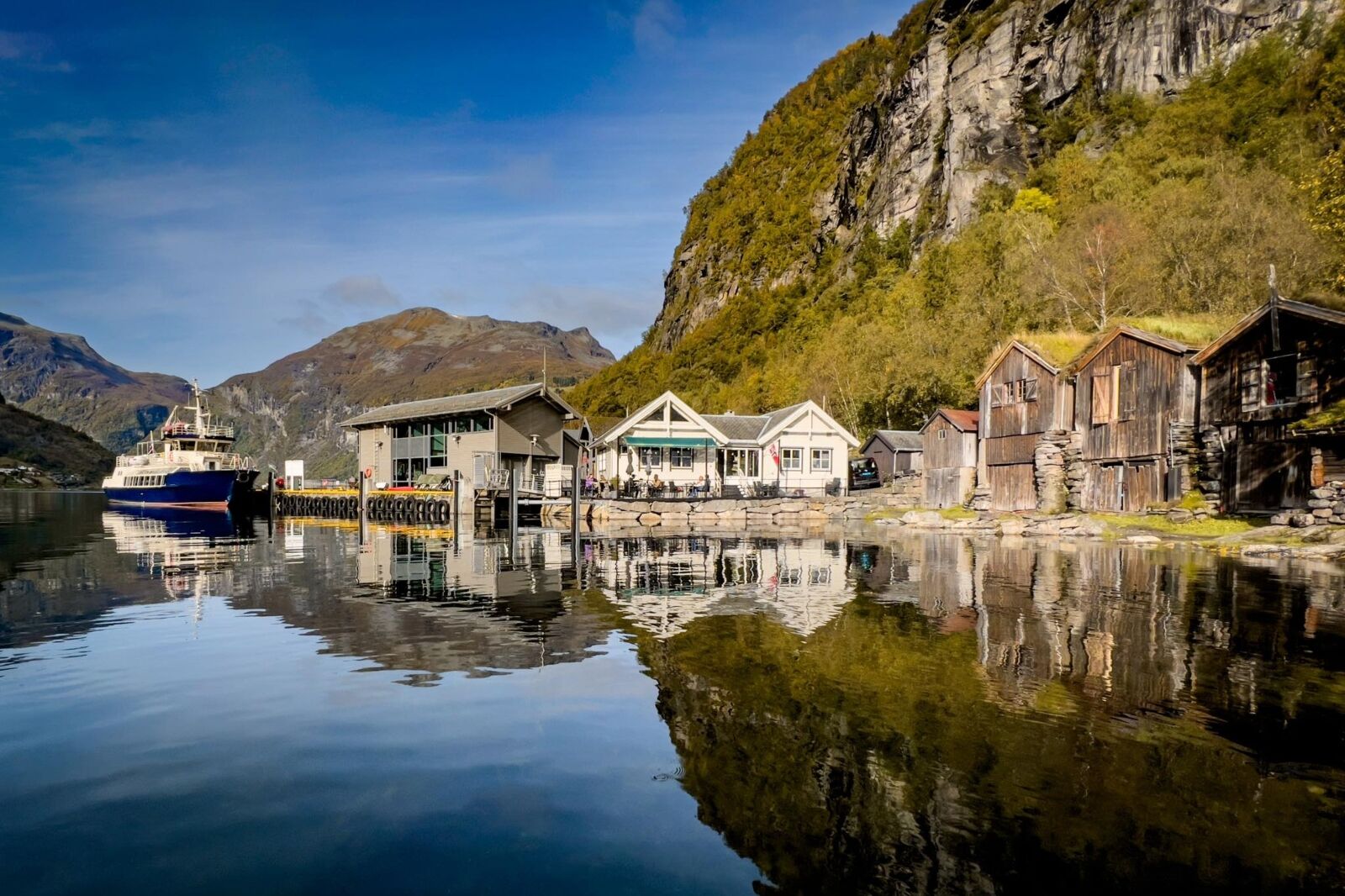
Photo: Brasserie Posten
Brasserie Posten
For a hearty lunch or dinner, go to Brasserie Posten, led by owner and chef Kenneth Løken. It’s situated on the waterfront, with outdoor seating looking out onto the fjord and the old boat houses that line Geiranger’s harbor. In addition to the restaurant, you can also pick up the company’s house-cured and dried sausage. Løken also produces cold and hot smoked trout and a delicious cured trout that I enjoyed topped with beetroot, a side of local sour cream, and homemade focaccia. If the sun is shining and the outdoor area is open, regardless if it’s a little fresh, sit outside during the day and enjoy the comings and goings on Geirangerfjord. For dinner, you’ll be treated to dishes such as slow cooked reindeer, warming fish soup with herb-baked rainbow trout and mussels, and a range of pizzas (including one topped with white nduja, pickled borretane onion, and pesto).
Brasserie Posten: Geirangervegen 4, 6216 Geiranger, Norway
Ålesund
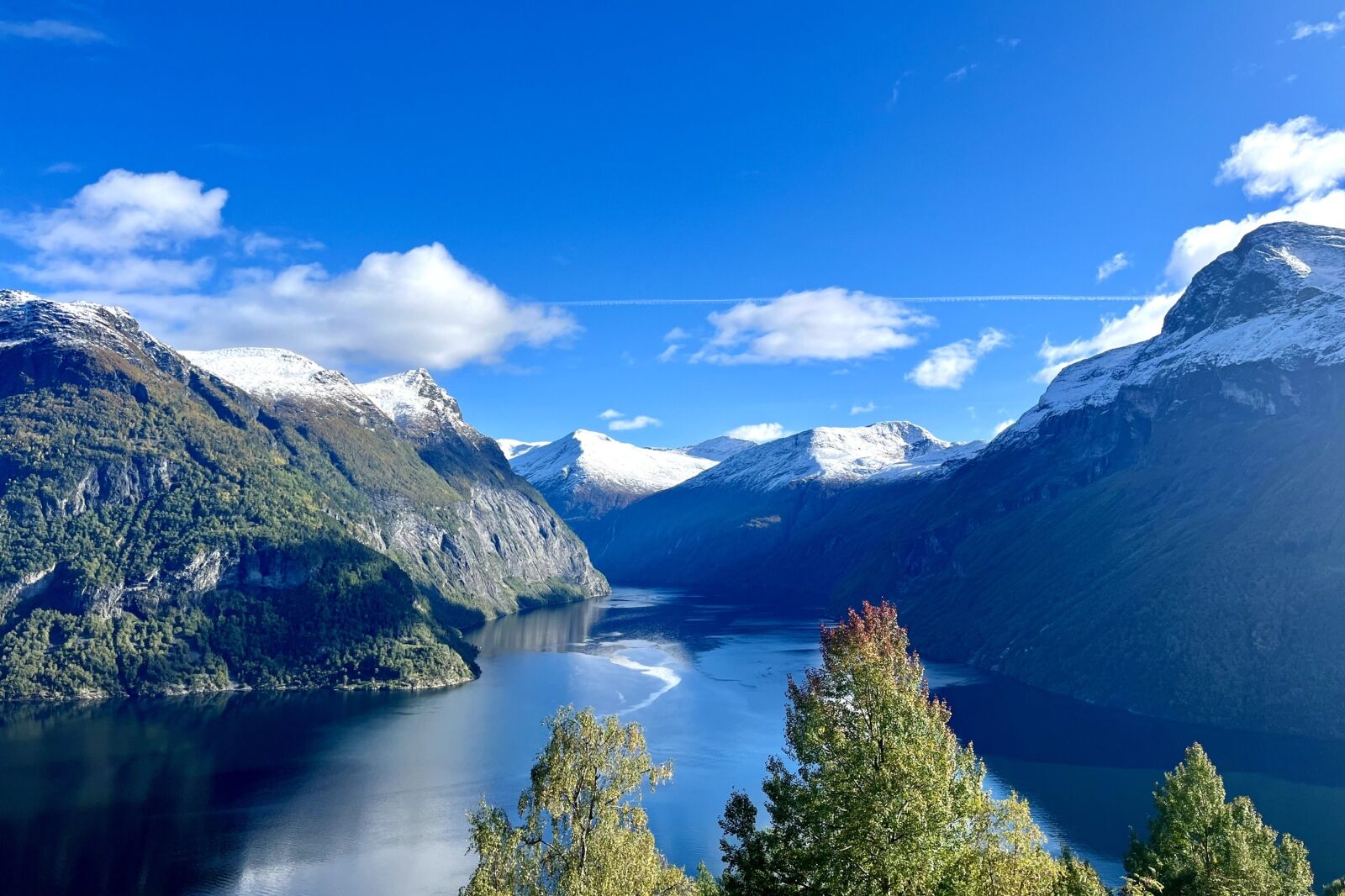
Photo: Katie Scott Aiton
When you’re ready to leave Geiranger, hop on the car ferry and cross the Geirangerfjord to Hellesylt. This ferry is privately owned, so it’s a little more expensive than others on this route. In return, you get a scenic sail through some of the most beautiful scenery in the region, including the famous Seven Sisters waterfalls, which cascade down the mountain. From Hellesylt, it’s another picturesque drive (about two hours) to the town of Ålesund.
Stay in Ålesund for a couple of days, at least. I was only here for one, and I wish I had more time. Admiring its colorful Art Nouveau architecture could fill a day alone. The coastal town has a fascinating history. Devastated by a fire in 1904, Ålesund was rebuilt in an Art Nouveau style, earning it the nickname “Paris of the north.” While walking the cobbled streets, remember to look up at the building’s details, and you’ll be offered a glimpse into a bygone era of elegance and innovation. For food lovers, shopping here is a delight. It’s home to one of the best butchers in the region, where I picked up some cured reindeer sausage, and lots of little delicatessens selling everything from local coffee to cured fish, cheese, salt and seasonings, and kitchenware. In the morning, go early to the harborside to meet the crab and shrimp boats. Here on the pontoon, I tasted the sweetest crab, which you can purchase directly from the fishermen.
Where to eat in Ålesund: Sjøbua
You’re spoilt for choice when it comes to dining, so again, if you can, take your time in Ålesund. For a memorable experience, reserve a table at Sjøbua in the fish packing district. Sjøbua, at a glance, is fine dining, yet when you enter, you’ll feel instantly comfortable. There’s a balance of brilliance of service, Michelin-star level cooking, and a beautiful ambiance to make dining here feel special yet unpretentious. My culinary journey began with grilled langoustine from Midsund with fermented leek, tarragon, and Rossini caviar. Buerre Blanc topped grilled halibut made a difficult decision for a main a little easier, and I finished with the most exquisite poached pear coated in caramelized white chocolate.
Sjøbua: Brunholmgata 1, 6004 Ålesund, Norway
Where to stay: Hotel Brosundet
My heart ached as I walked into the lobby and took in the three-story, floor-to-ceiling fireplace at Hotel Brosundet. I yearned for more time. A stay here made leaving Ålesund harder, a testament to the warm service, the intimate atmosphere, and the stylish-I-want-this-in-my-home decor. A former warehouse, the hotel was renovated in 2017, and its quayside location puts it within strolling distance of Sjøbua and the cobbled streets of the main town. Many rooms offer views over the ocean. Waking up here feels more like a luxury retreat than an inner-town hotel. In the evening, sit at the copper-clad Arkivet Bar and eat at Apotekergata No.5, the hotel’s brassiere, which was buzzing with life during my stay. The pièce de résistance is the spa’s harborside outdoor bathtubs, which you can reserve and melt into the bubbles as you watch the fishing boats come and go.
Hotel Brosundet: Apotekergata 1, 5, 6004 Ålesund, Norway
